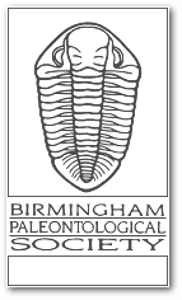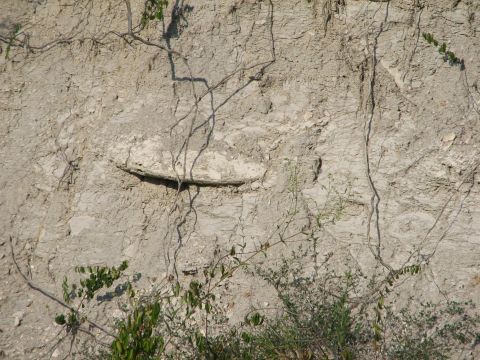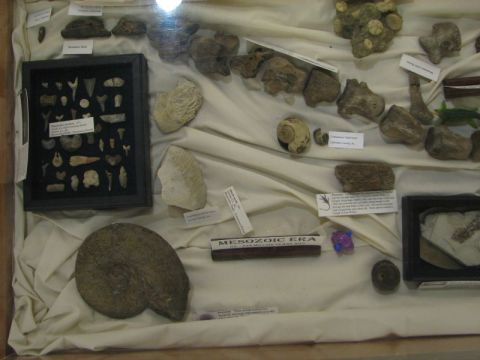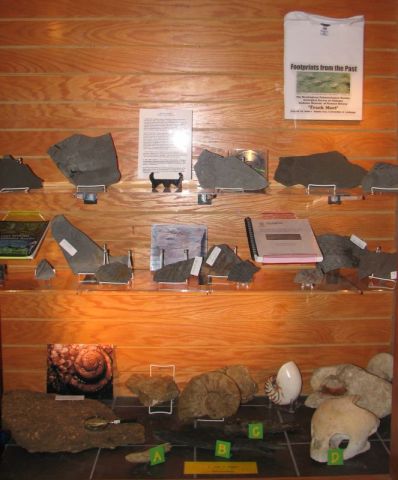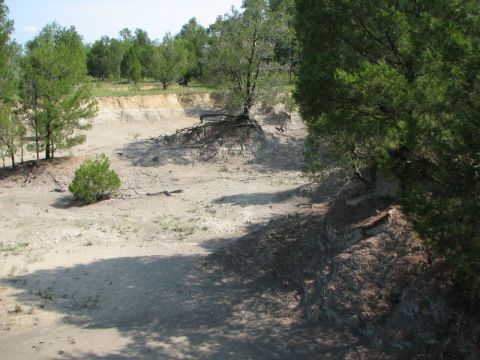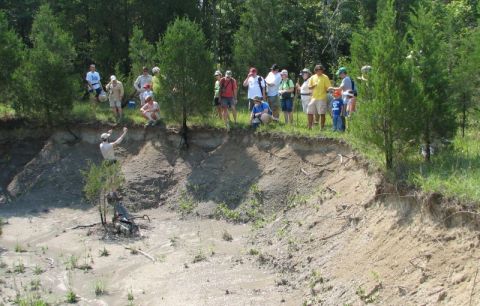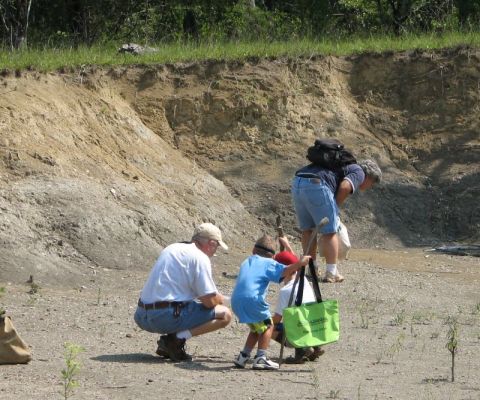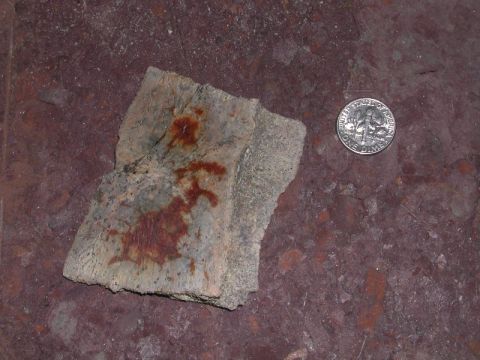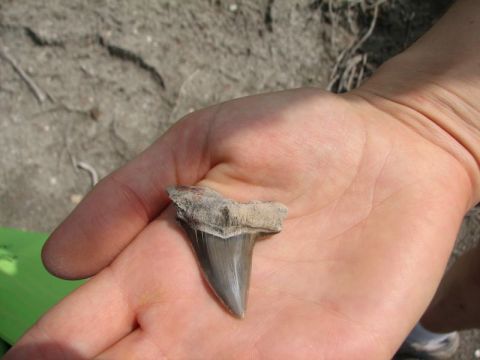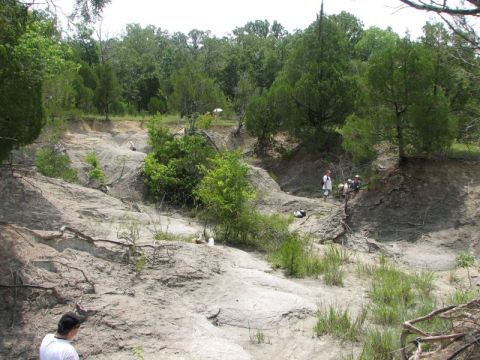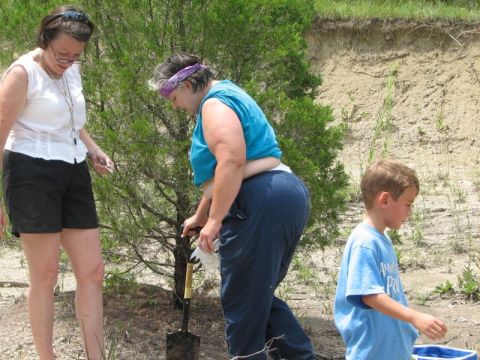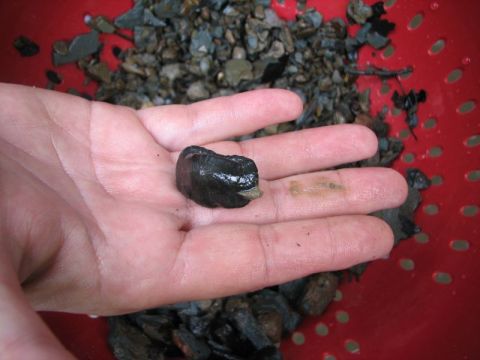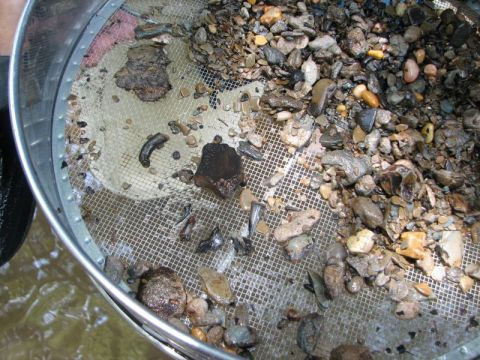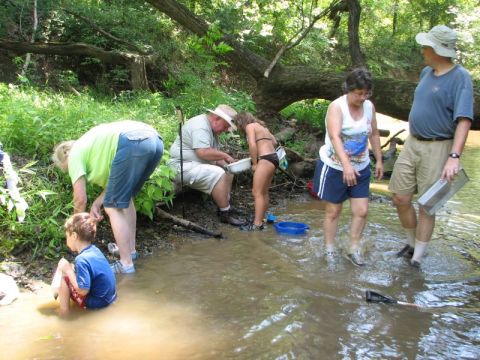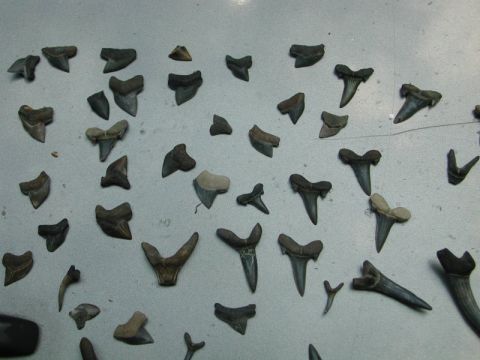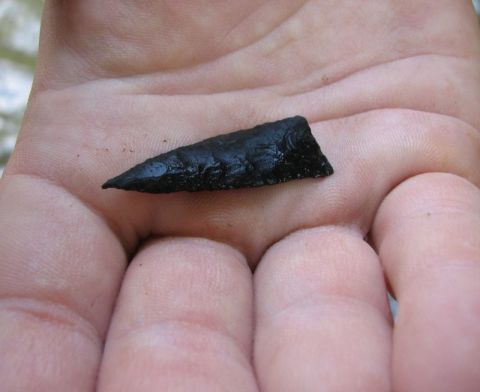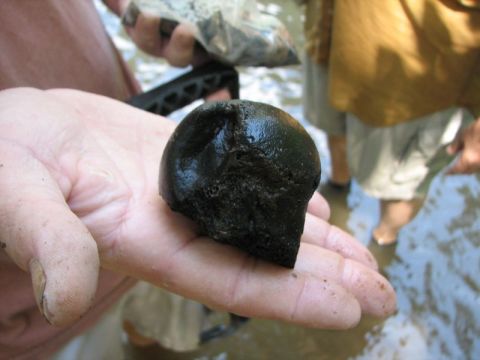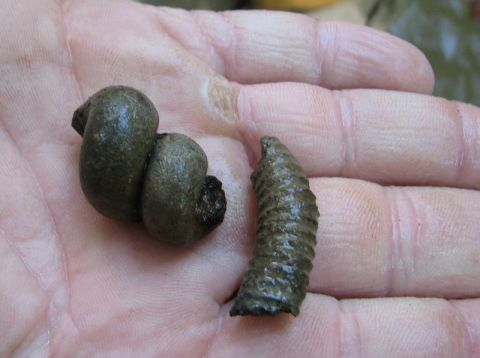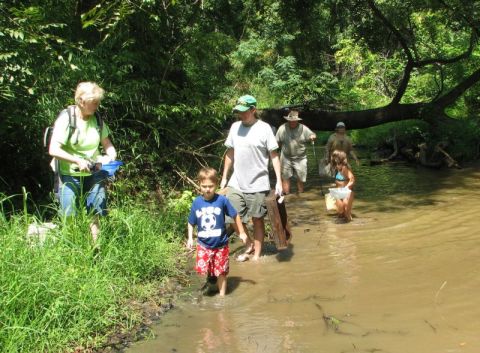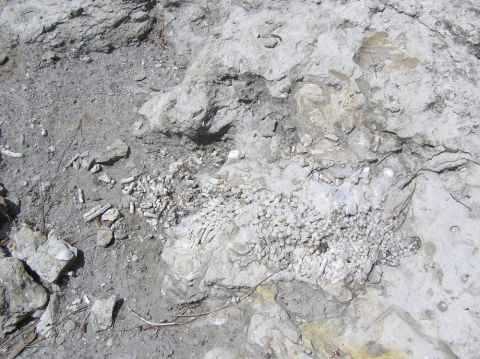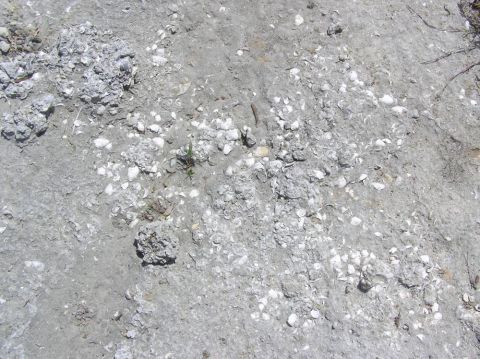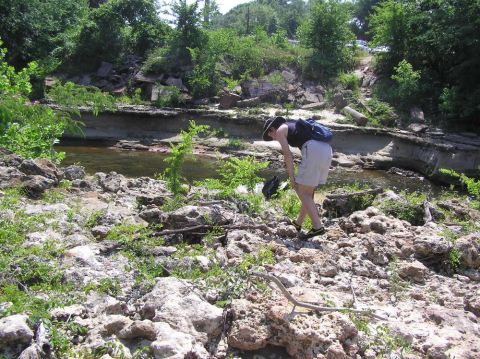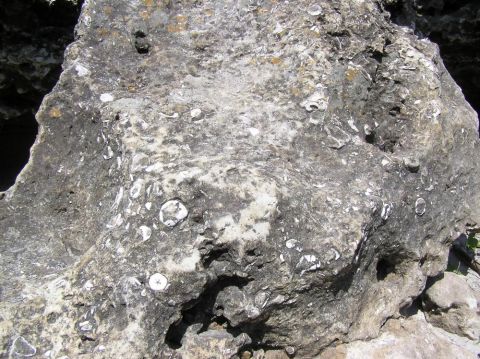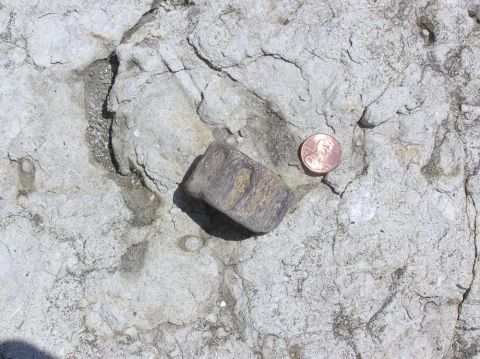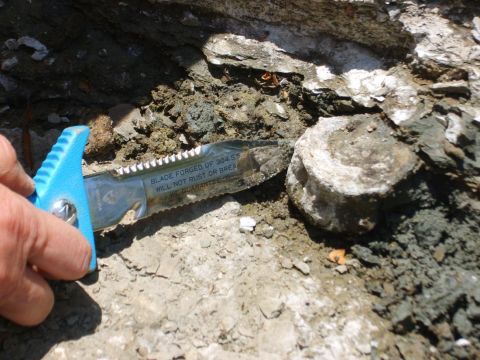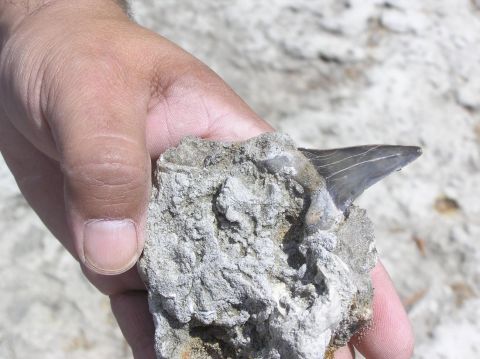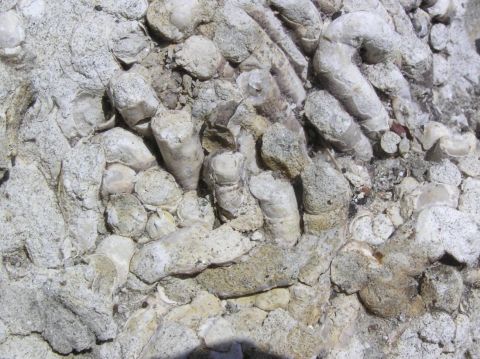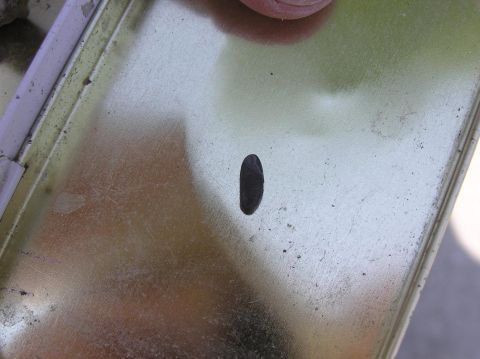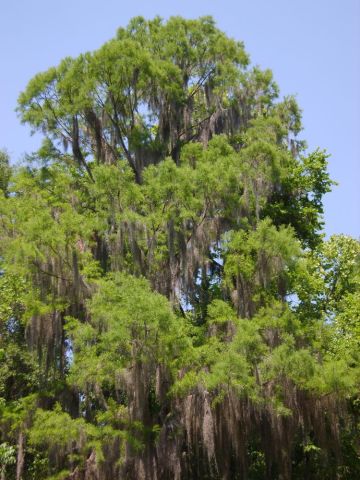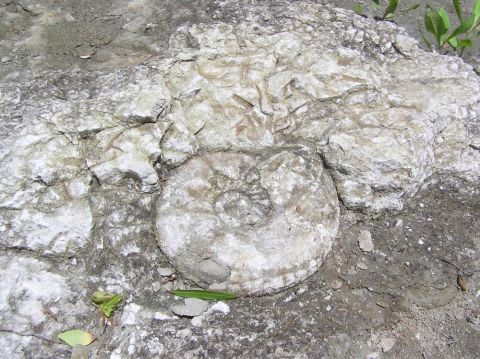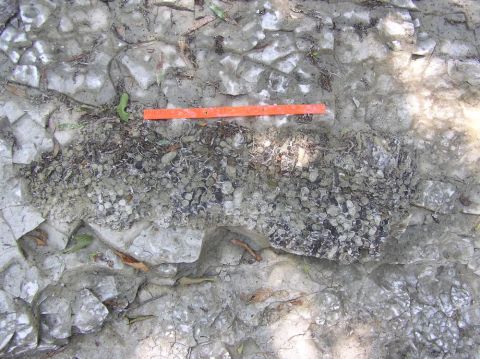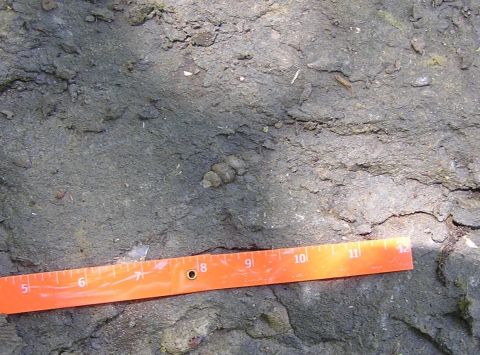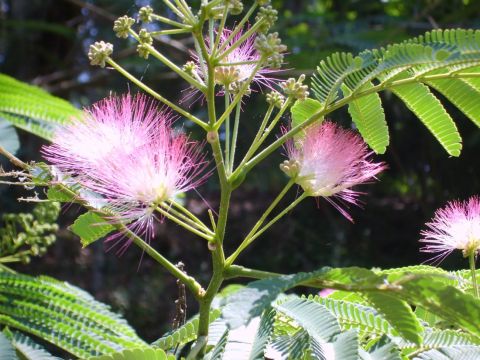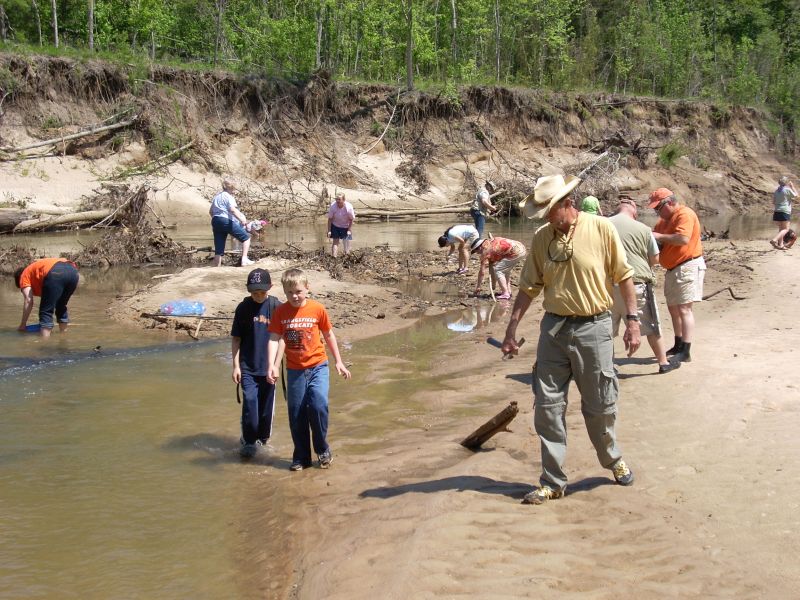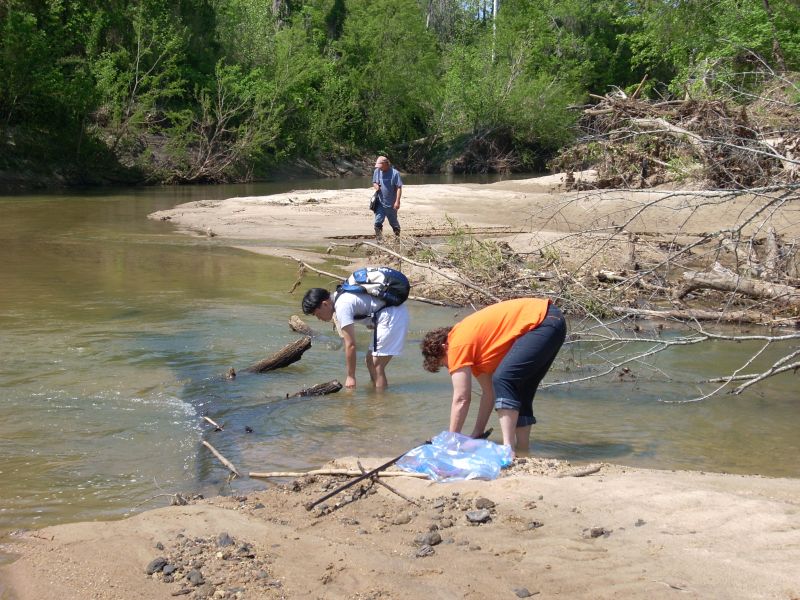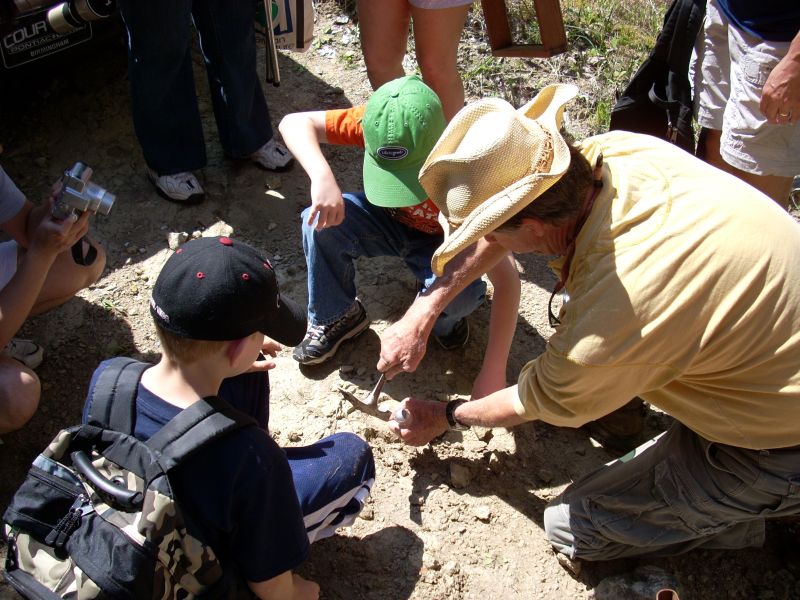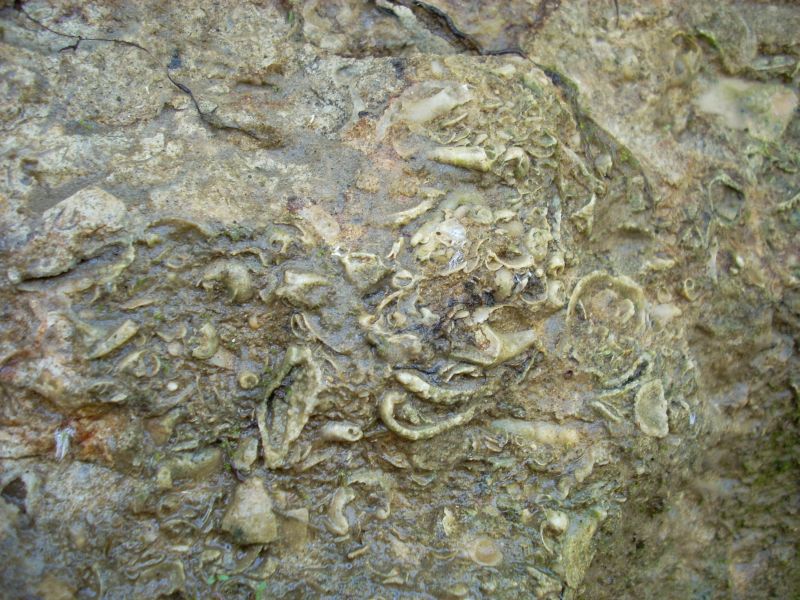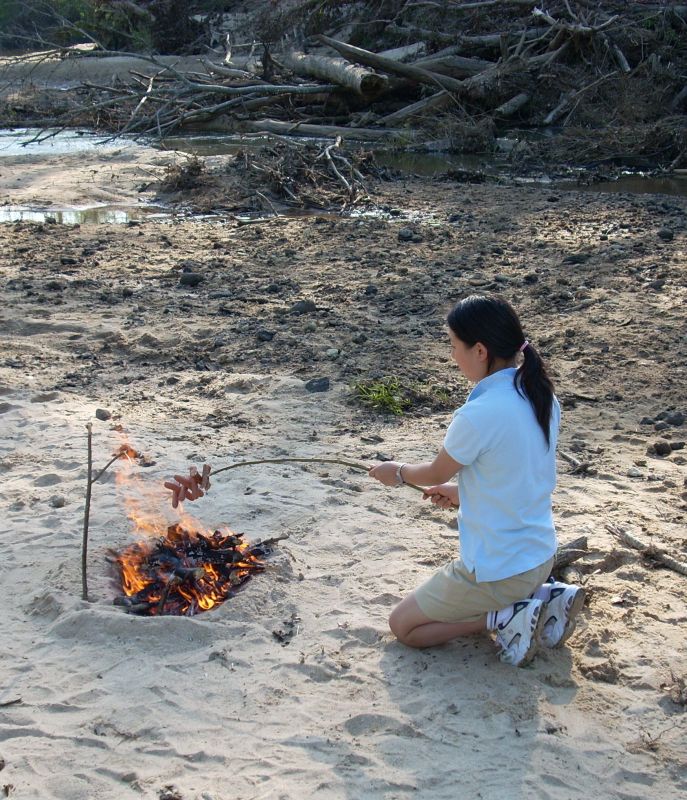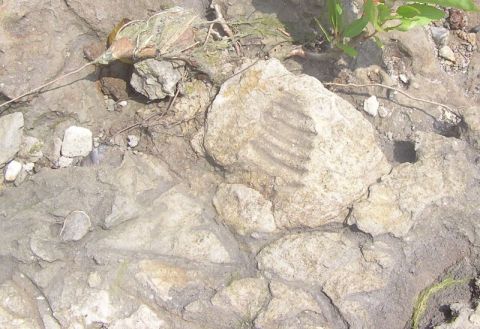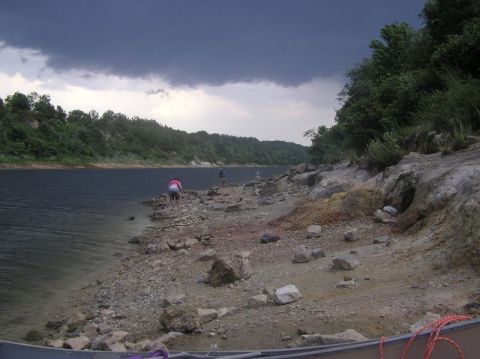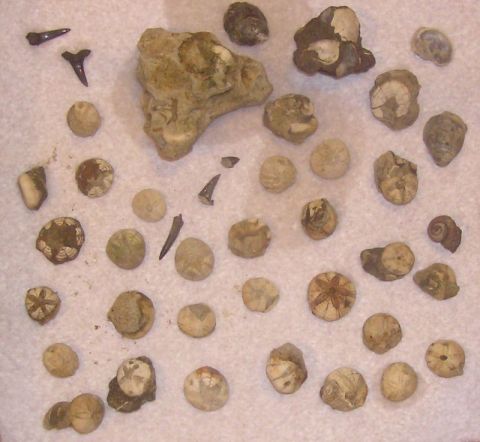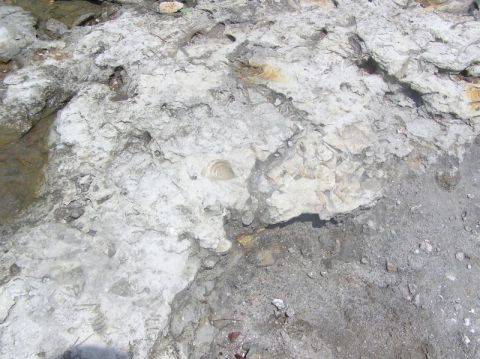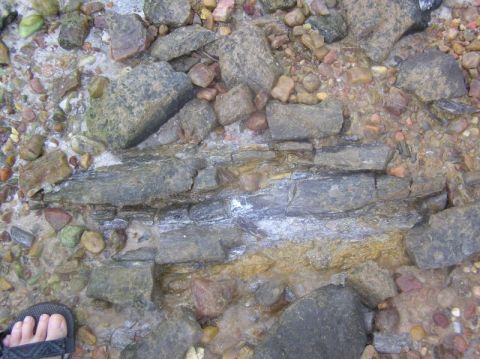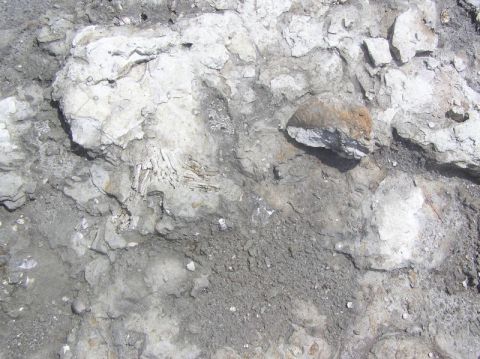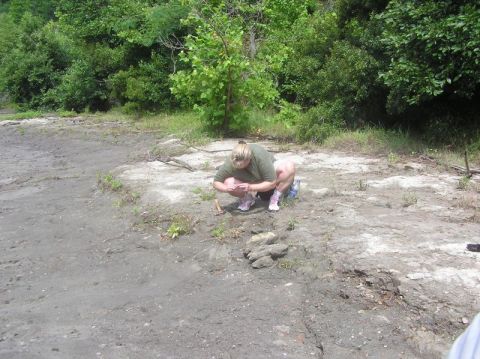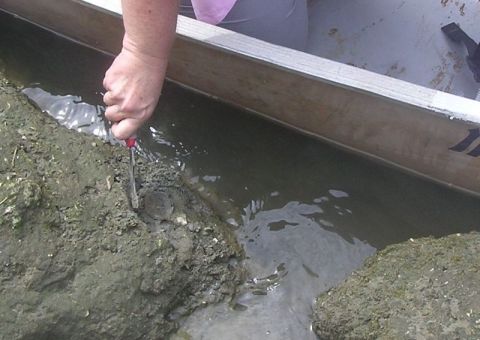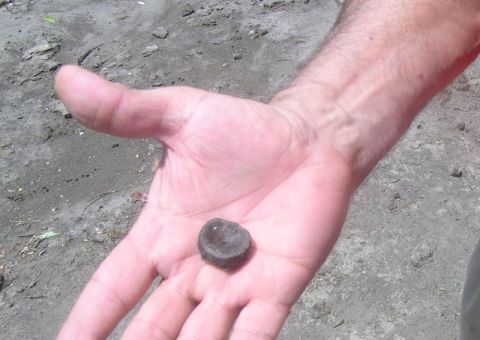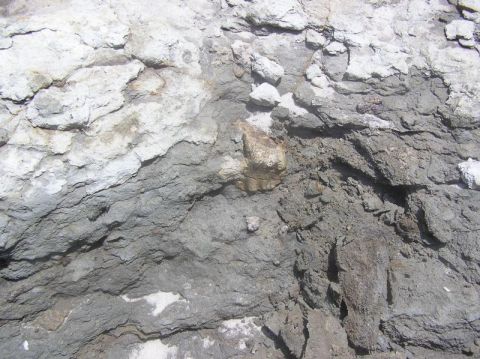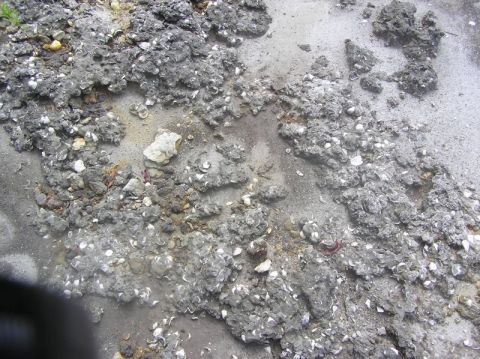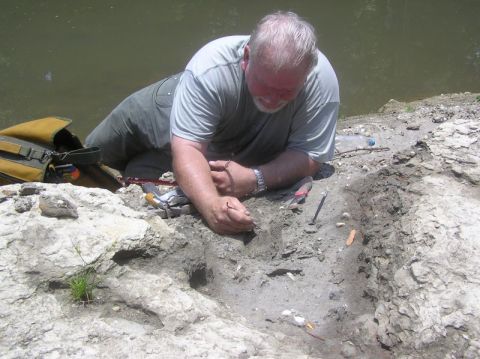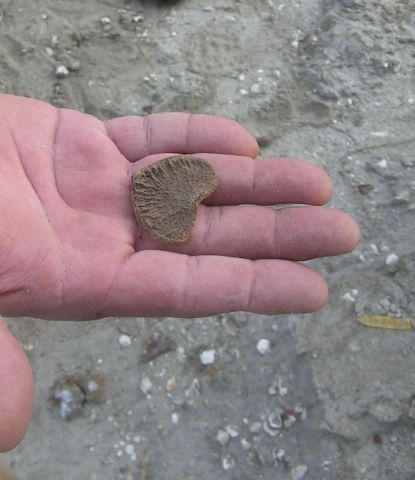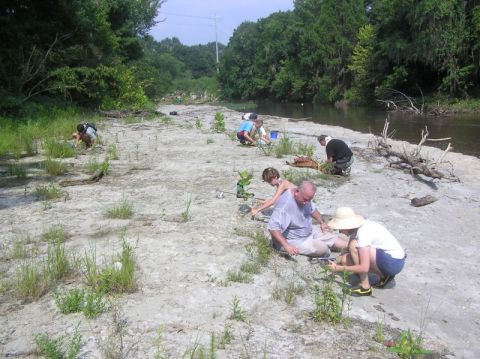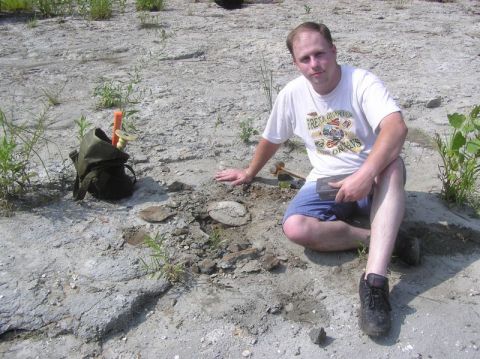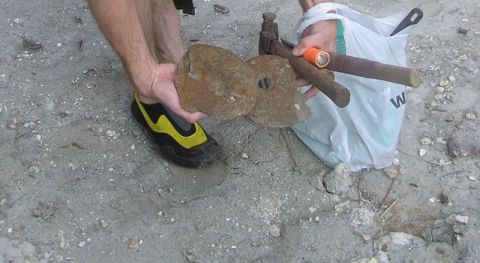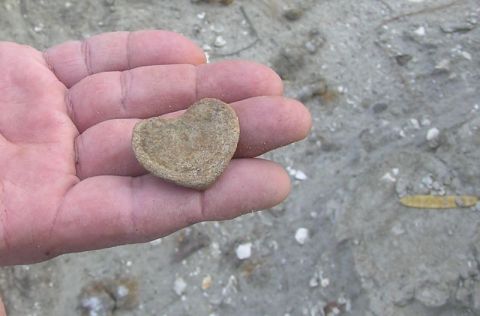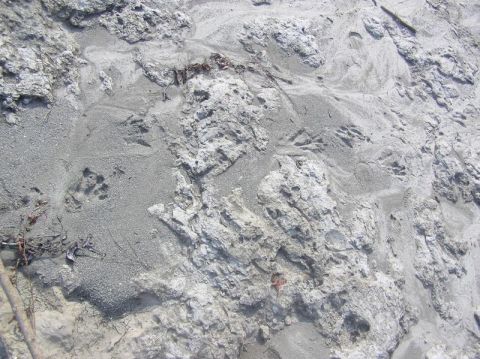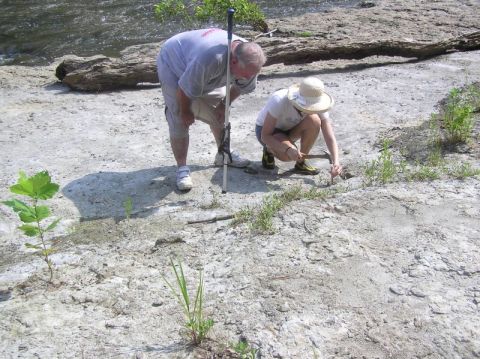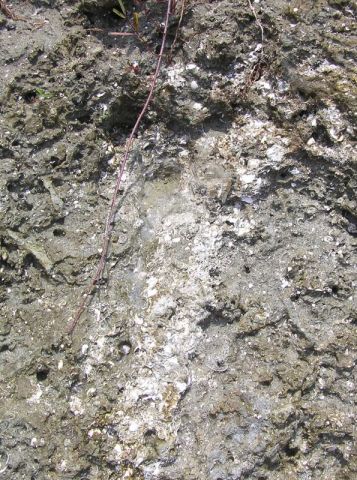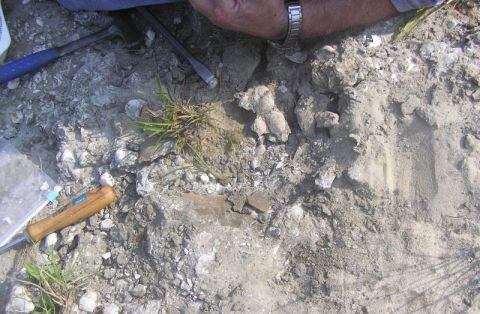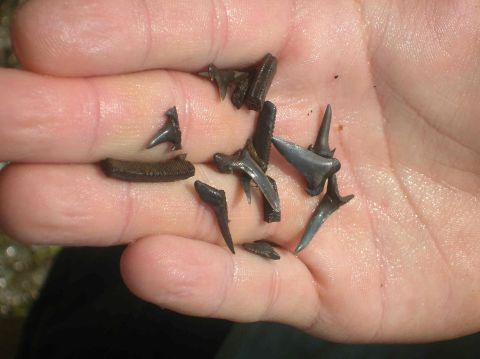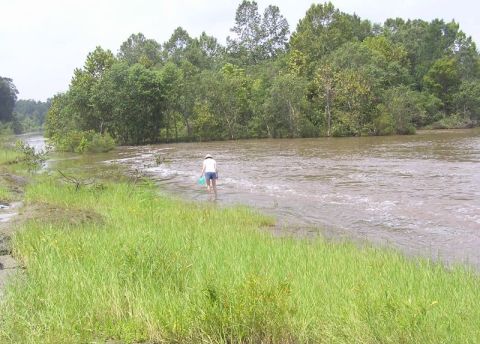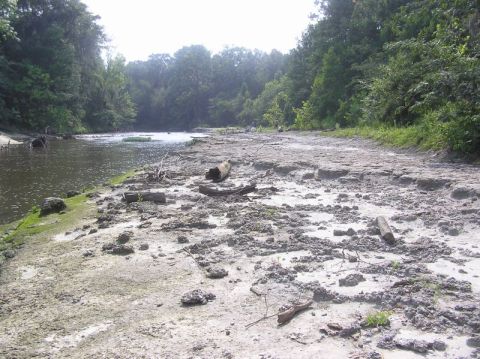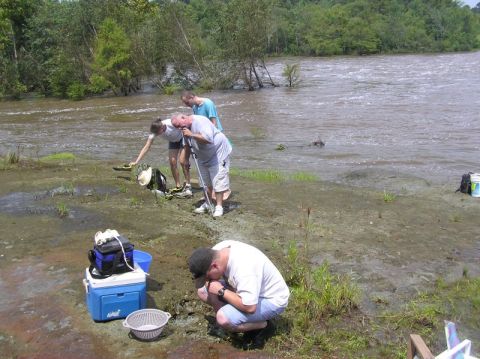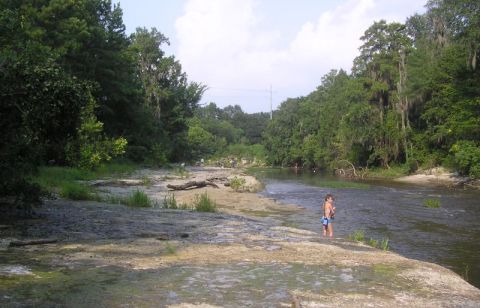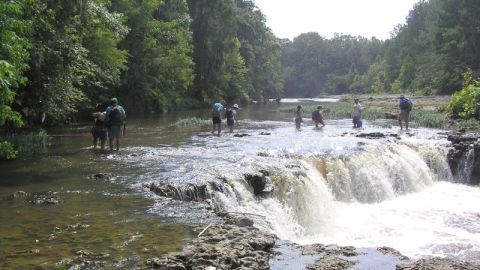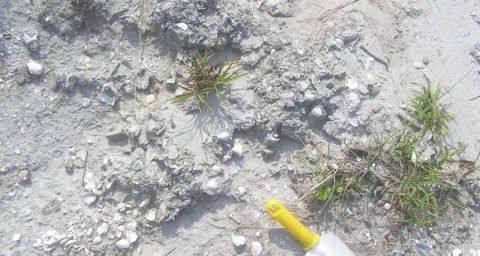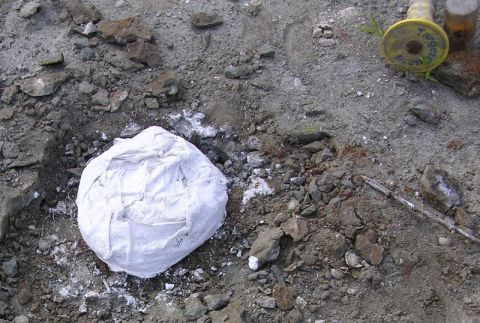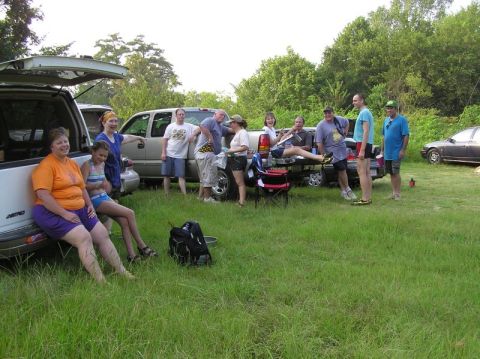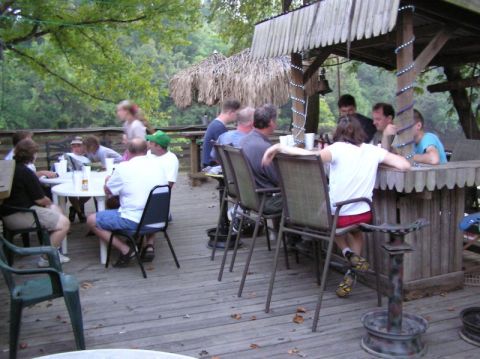James Lamb gives a refresher talk on rules about collecting at museum sites, BPS ethics, and landowner restrictions.
Visitor
ammonite
July 21, 2007 - Cretaceous Fossils, Greene Co, AL
After rounding up the gang (which is a minor miracle in itself!), we hiked back to our vehicles for lunches, then headed for the creek. Finally, time to get wet and cool off! Out with the sieves, from collander baskets to "real" geology sorters, to home made wood-sided screens. At least a dozen ptychodus teeth turned up - Claire may be the "winner" on these, she had found 6 at last count. Every screen we searched had several shark teeth, and other fossils were also found, including a large fish vertebra, gastropod steinkerns (internal molds), worm tubes, and one very nice arrowhead. We left relatively early (hey, some of us would have stayed til dark if we could have!), and many of us stopped by a famous BBQ joint to continue the fun and fossil discussion.
--Edited by Vicki Lais
(photos courtesy Bob Stewart, Steve Corvin and Vicki Lais)
Many "pieces" are scattered throughout the gully, and according to James Lamb, they are all fossils.
Some typical fossils found in chalk gullies - one finds hundreds of worm tubes, and only a few shark teeth.
Shark teeth are "normal" to find in gullies, but Sylvie found one whose size is truly spectacular for these gullies!
Small mosasaur vertebra found by Leisa as we were leaving the gullies "Everybody just stepped right over it or passed it by without noticing".
Typical finds after washing the sand/mud from the gravel - notice the shark teeth and the piece of bone.
A laid back group, keeping cool, having fun. There were various groupings of people all along the creek - some went upstream, some went downstream. James Lamb is collecting material to be used in an upcoming exhibit at McWane Science Center.
- ‹ previous
- 3 of 4
- next ›
May 19, 2007 - Cretaceous Fossils, Montgomery Co, AL
Large Cretoxyrhina mantelli (Ginsu shark) tooth
Small pycnodont fish tooth - Genus Anomoeodus.
Small pycnodont fish tooth - Genus Anomoeodus.
- ‹ previous
- 3 of 4
- next ›
April 21, 2007 - Cretaceous and Tertiary Fossils, Butler Co, AL
Everyone met at a central location, and a brief introduction to the geology of the area was given before driving about 12 more miles to the entrance to the site. While past trips to this location have found the entrance roads to be very slick from rain, this years access was dry and easy. The entire caravan was able to drive to the limestone hilltop parking area.
The fossil hunting started the moment you exited your car with small gastropods and segments of large ammonites being found on the cleared hill top. The trail down to the creek provided more ammonites.
The creek was beautiful with white quartz sand beaches at many of the bends. Shark teeth, ray teeth, fossil bone, ammonite pieces and nautiloids were found in the gravel bars, along with numerous non-fossilized bones and teeth from various mammals. Some of the more interesting finds were various human artifacts rather than fossils. Indian potshards, some with incised decorations, a couple of projectile points and an Indian pipe, probably of European origin, were found.
The end of the day found the diehard fossil hunters resting at the beach where the trail intersected the creek. The Novaks organized a fire on the beach to roast small sausages, while others brought snacks to contribute, and the Stewarts returned to the parking area to set up camp for the night and fix their dinner.
By dark, everyone headed home, leaving Pam and Bob to enjoy a pleasant night at the site with owls hooting and Whip-poor-wills calling. At daybreak turkeys could be heard at the tree line adjacent to the camp area. After a couple of hours of walking the creek on Sunday morning the Stewarts packed up and reluctantly left the site, letting it return to nature.
(Photos courtesy Jan Novak, Bob Stewart, Becky Guthrie, and Vicki Lais)
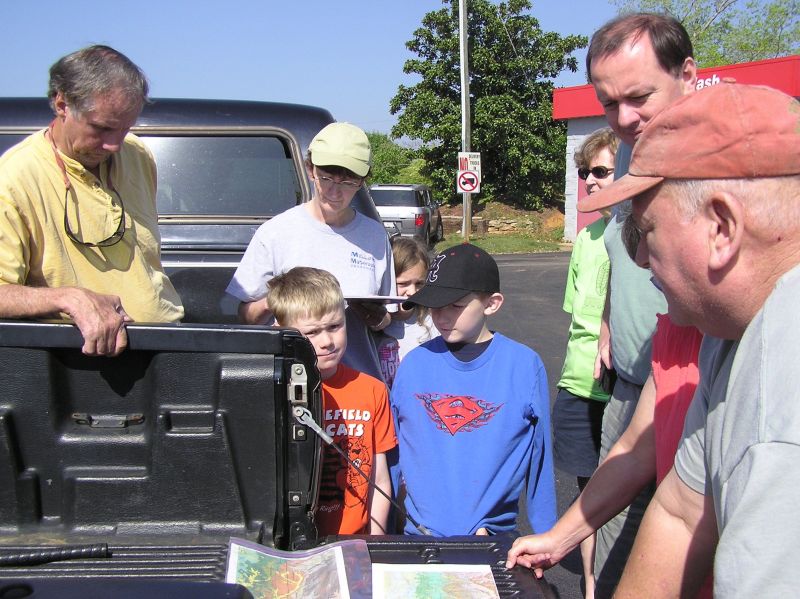
Vice President Greg gives an overview of the geology of the site and collecting rules.
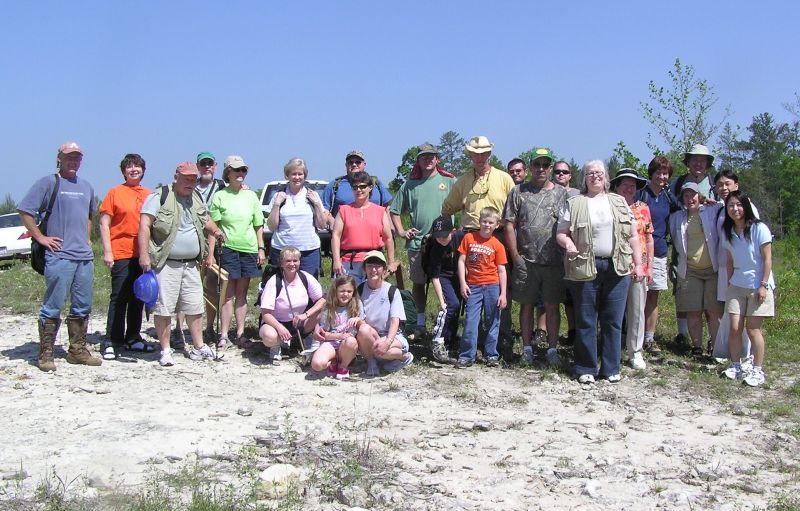
A lot of excited people showed up for the field trip - fossils can even be found on the limestone earth in the foreground.
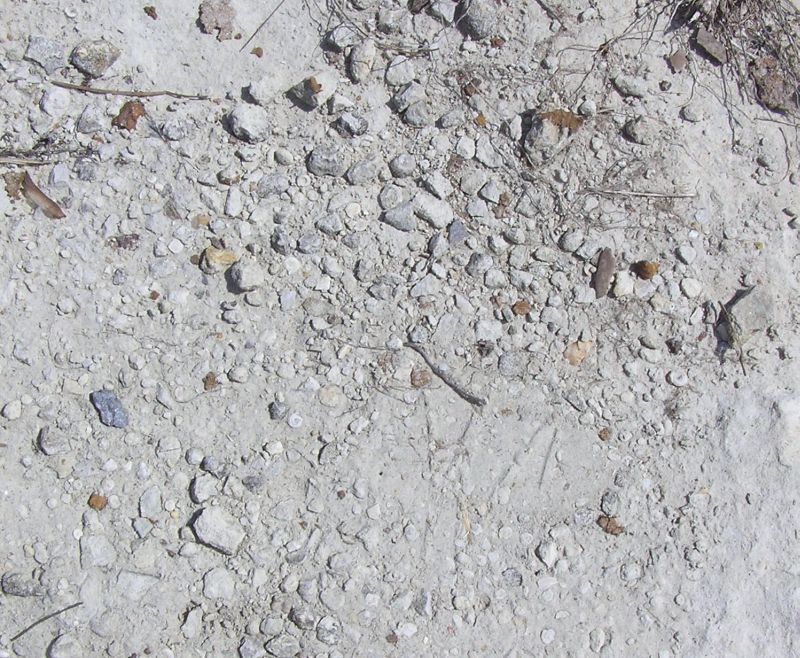
If you look carefully, you can spot tiny round gastropods, each approximately 3/8 inch across.
Hiking down to the creek from the parking area (and of course, looking for fossils along the way!)
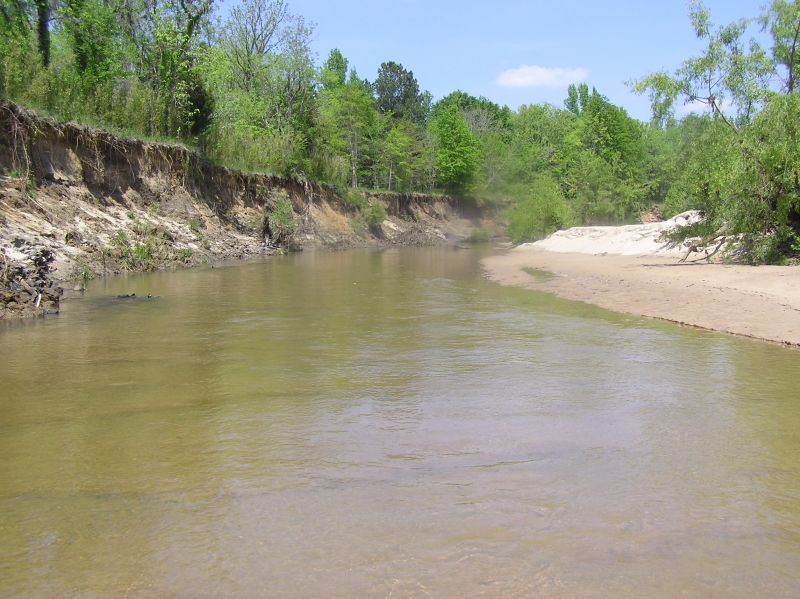
The creek was higher this year than normal, but there were still numerous gravel bars.
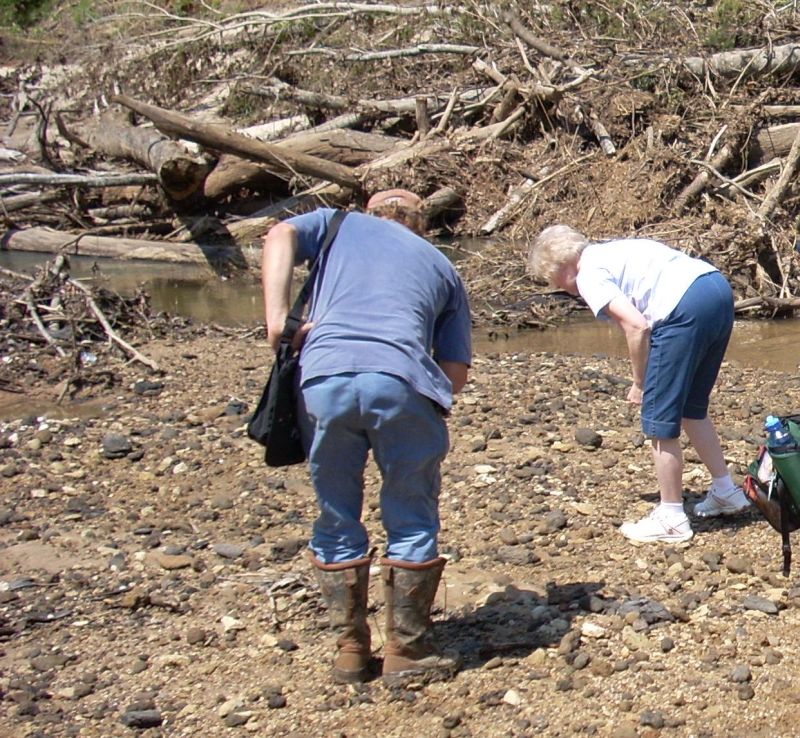
A recent storm had washed up a huge pile of brush and trees, and left behind rocky rubble and mud rather than the white sand we normally find.
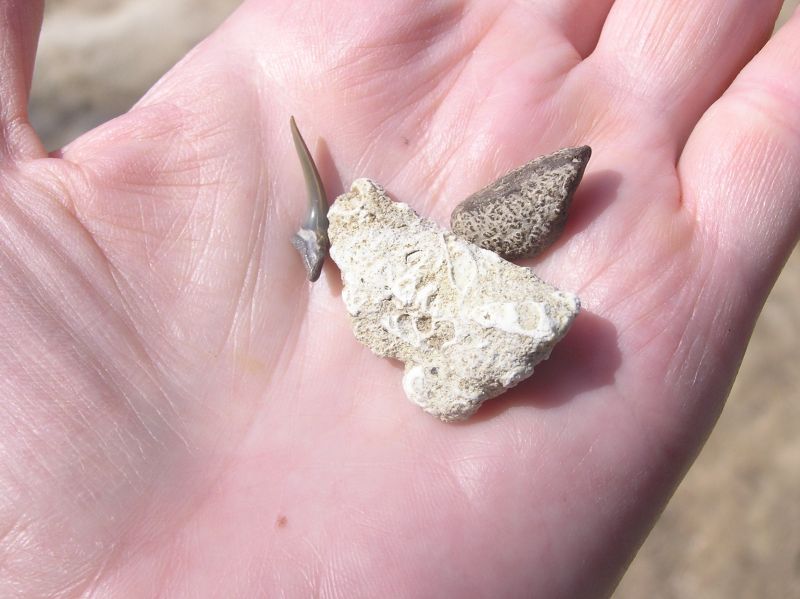

Nice nautiloid found by David.
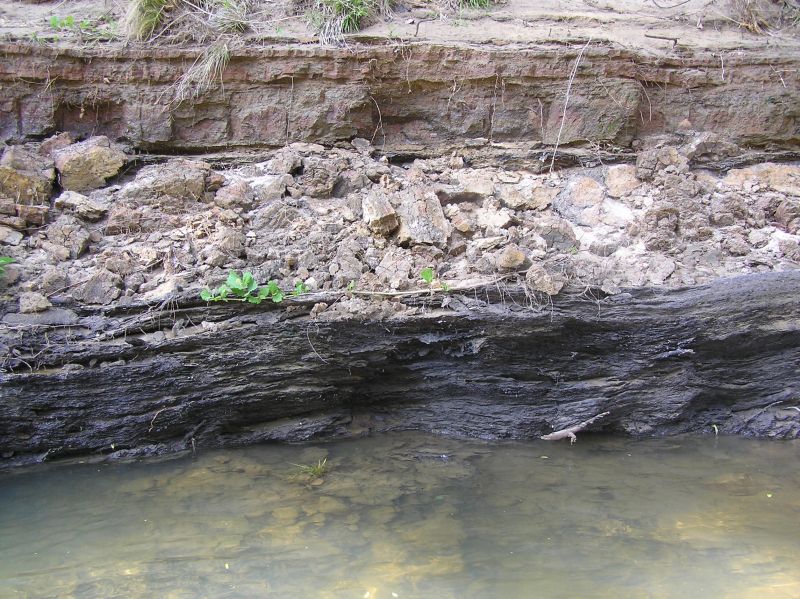
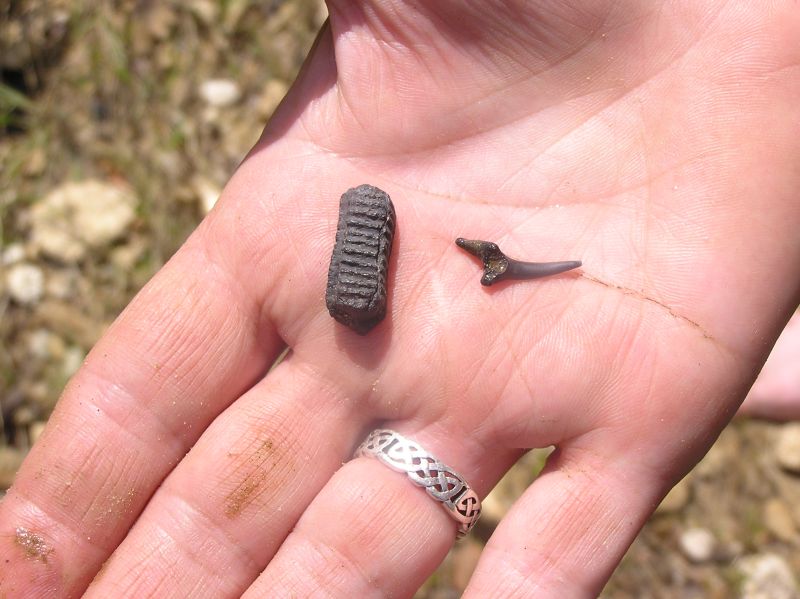
Ray tooth and shark tooth.
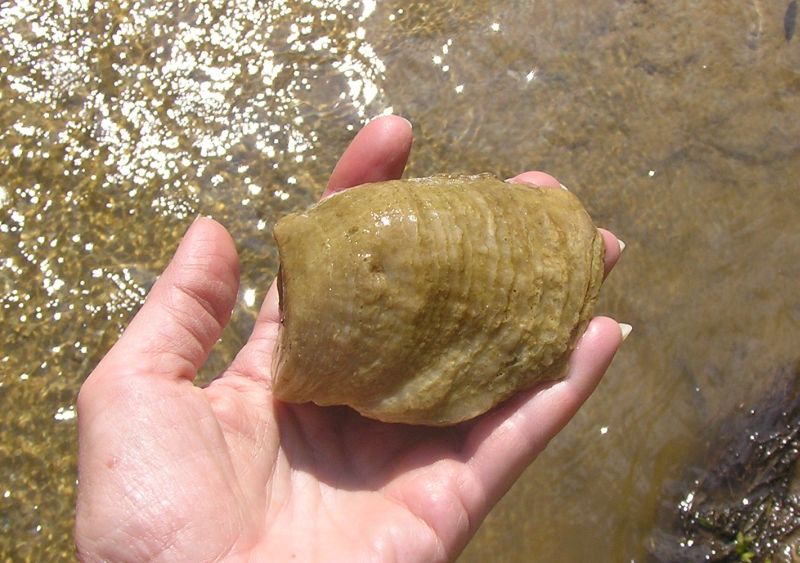

Unknown item, can anyone identify? Looks kind of like a tooth. . . .but . . . .
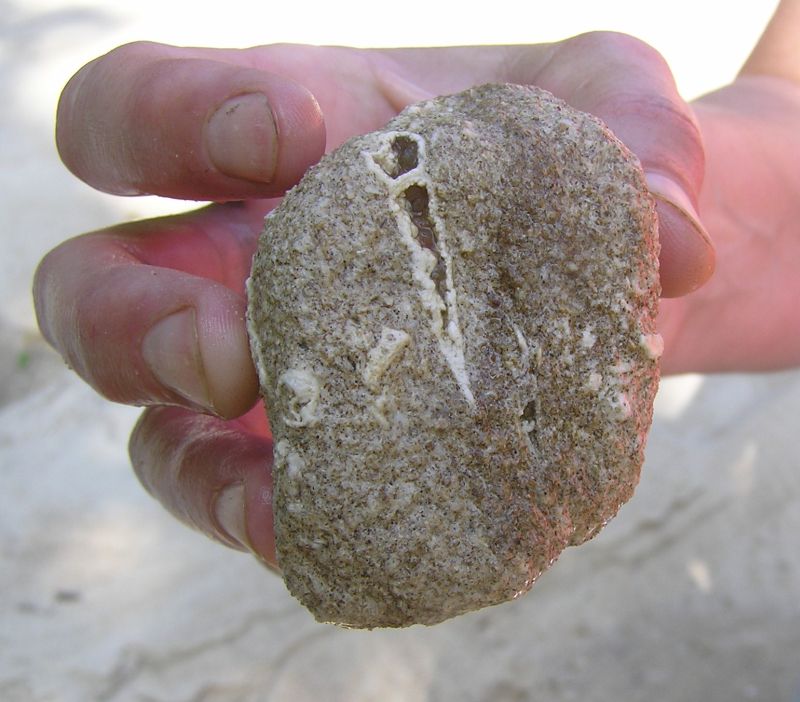
Nice turritella in coquina.
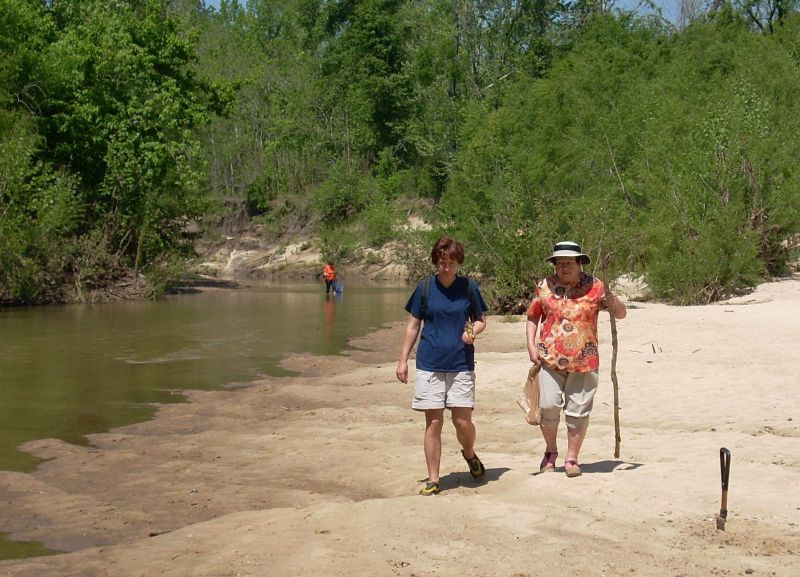
Lea's mom was visiting from the Czech Republic, and decided to join us for the fun!
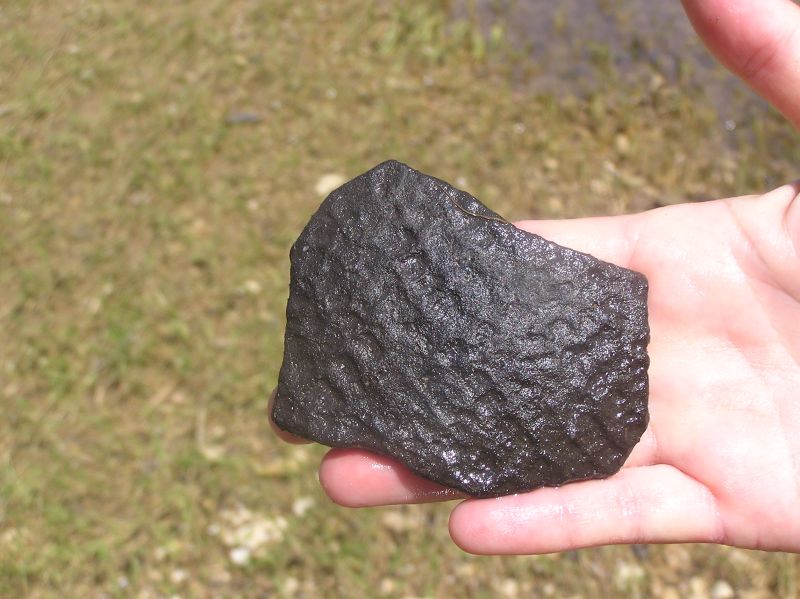
Shells in matrix.
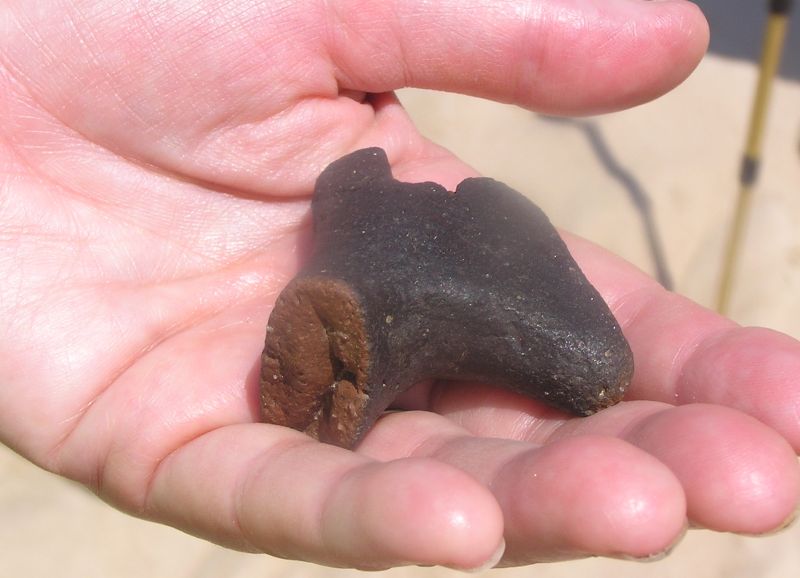
Probably a pottery handle.
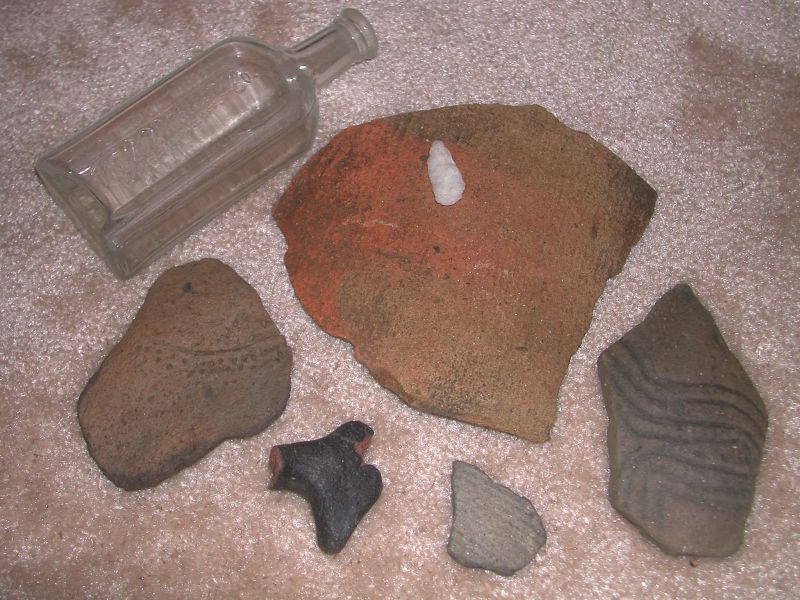

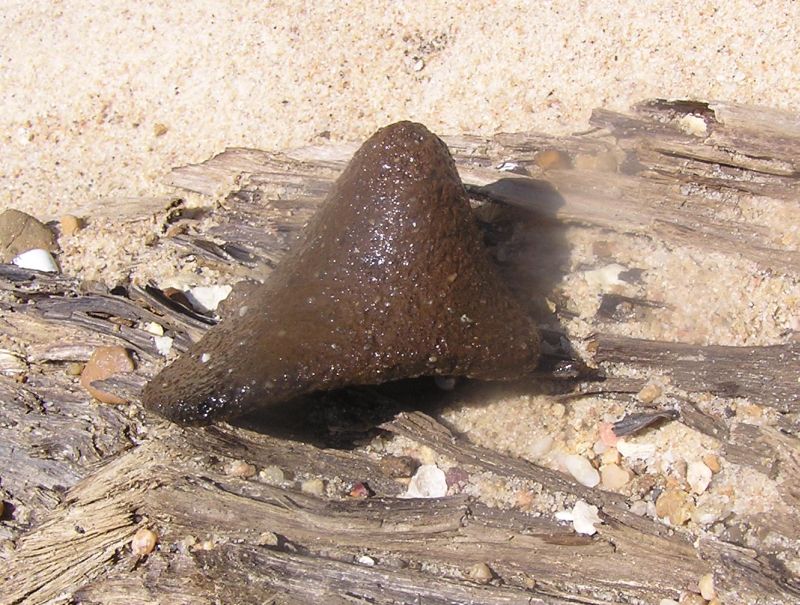
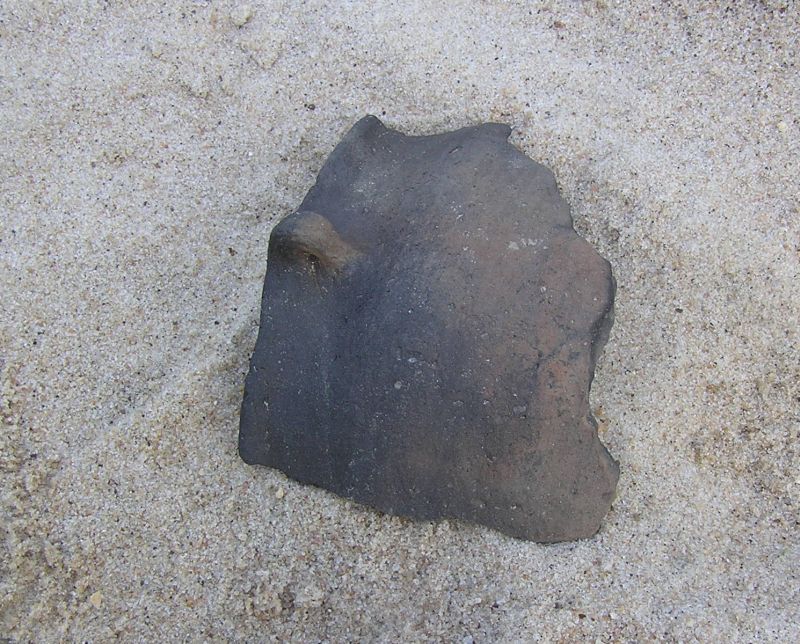
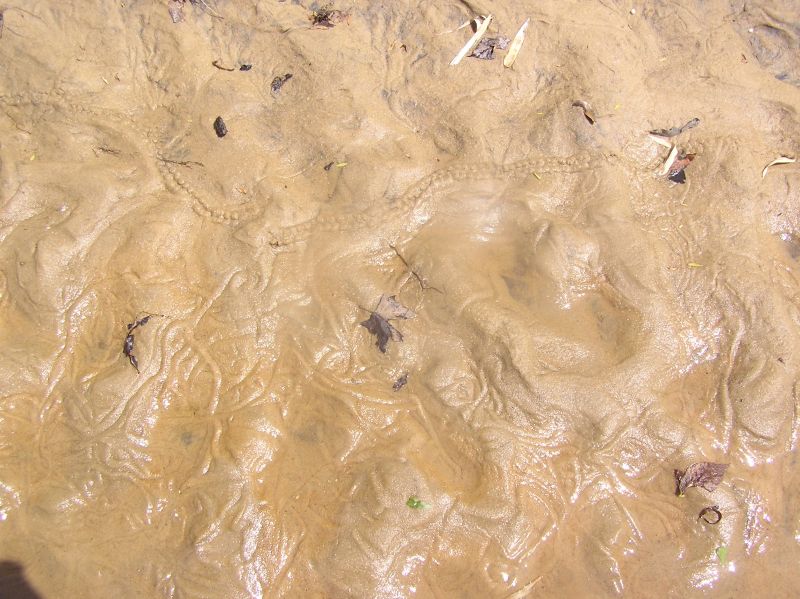
Worm tracks in the sand. Fossil worm tracks much like these are found in shale in north Alabama.
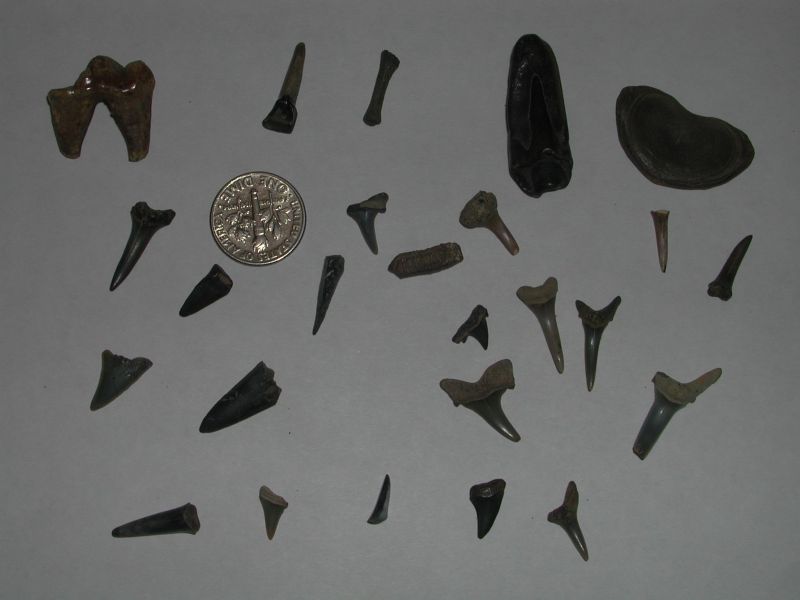
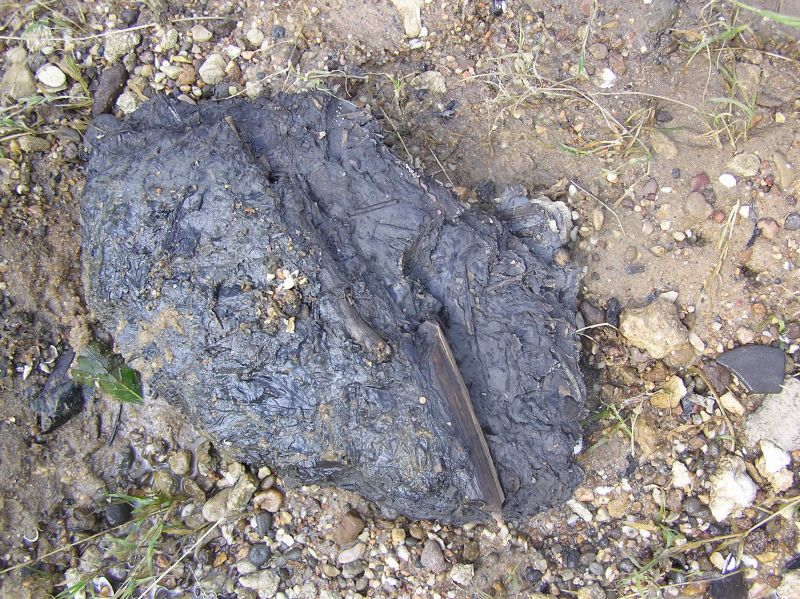
Numerous clayballs were found in the creek. This one shows bits and pieces of plant debris. The finder did not examine it closely to determine whether these were fossil leaves or recent, however, based on the geology of the area, they could easily be cretaceous fossil remains.
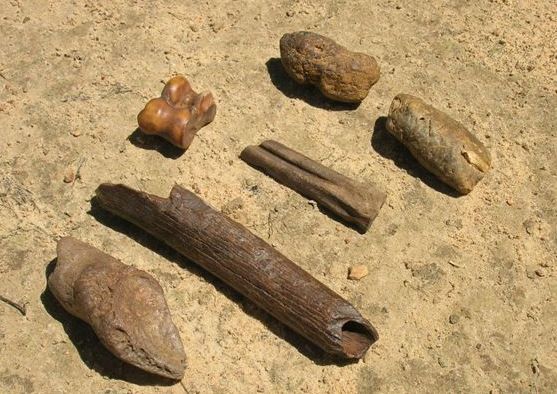
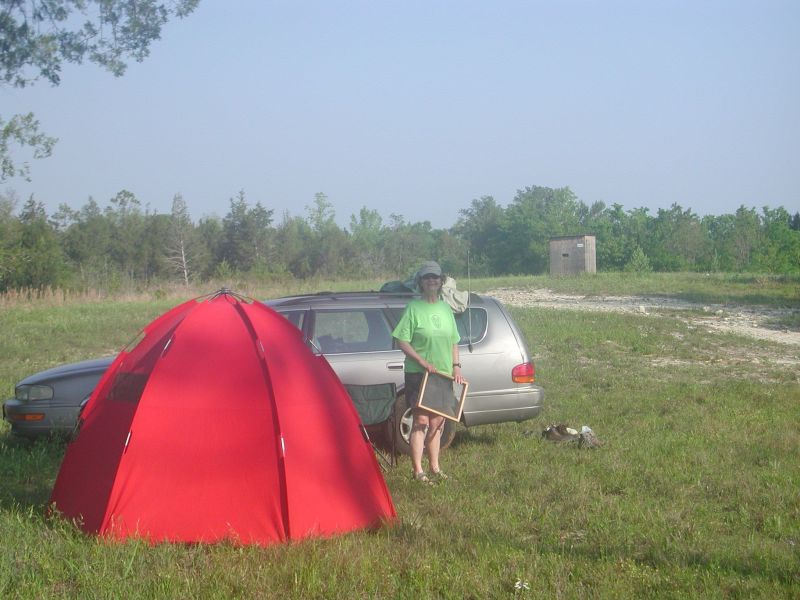
While Bob & Pam set their tent up . . .
The others built a fire and enjoyed the evening.
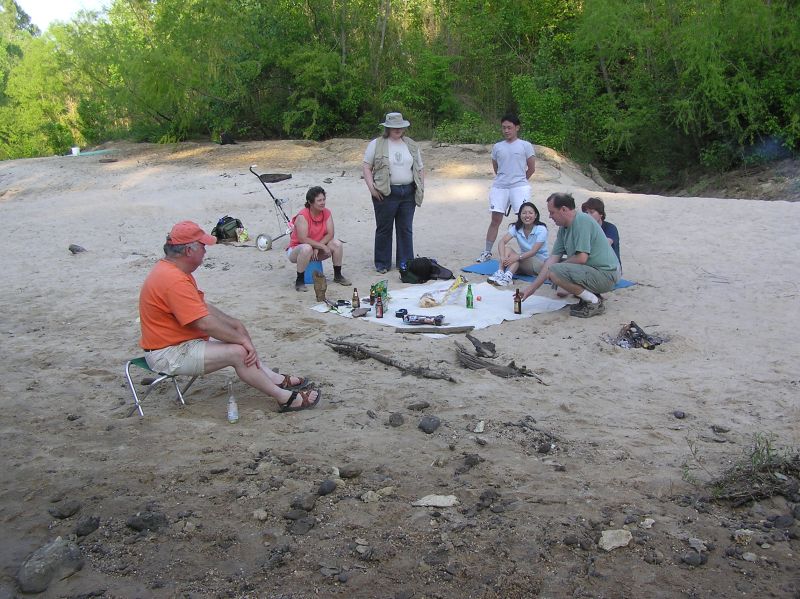
The campfire has about died out as some of the diehard fossil hounds hang out wringing that last little bit of enjoyment from the day!
August 19-20, 2006 - Cretaceous Fossils, Lowndes Co, AL
Once again BPS was out in the boonies with the ATV’s! Greg even brought his own ride this trip. Go, Greg! Gorgeous weather, good turn-out. Sandy Ebersole, a new BPS member from the Geological Survey of Alabama, was interested in examining the formation to determine if it is part of the same Ripley Formation she is studying at Coon Creek in Tennessee. Sandy and Jun Ebersole both gave us a short overview of the formations and geology of the area before we started collecting, which left us with an excellent perspective on where we were going.
We explored several small creeks in the area for the first time, where we found a number of crabs and other items, including clams, in nodules. Sandy found an outcrop in the first creek where she gathered numerous samples for her research.
The main creek yielded great samples for all: more crabs and clams, and unknown items in concretions. Sandy located another interesting outcropping and took more samples of microfossils. Michelle found some nice ammonite pieces, including one piece showing beautiful suture marks.
Since the Ebersole's needed to leave that night, our hosts set up an impromptu trip to a gully for the evening. Sandy and Jun wanted to see if this was part of the Ripley Formation (current thought is - probably not). Jun got a quick lesson on ATV driving and we hit the gully where we found teeth and bits of shells.
The next morning before the mist had burned off, we went to a different gully that had not been explored for several years, but did not yield many finds. After returning to camp, and meeting new arrivals, two groups were formed. One group went back to the creek where the crabs had been found, and another group consisting of Vicki, Michelle and Becky took off on a scouting adventure to explore yet another “new” creek. This turned out to be a great spot with some decent finds of brachiopods, clams, gastropods, exogyra, shark vertebrae, and possible pieces of bone.
Later in the day, diehards Becky and Vicki explored the main creek again, using a different access point and went a little ways up the stream until the creek got too difficult to navigate.
After two days of excellent collecting, all went their way home and look forward to the next field trip.
Edited by Vicki Lais
(Photos courtesy Vicki Lais)

On the way again! Riding to the site is almost as much fun as the collecting itself!
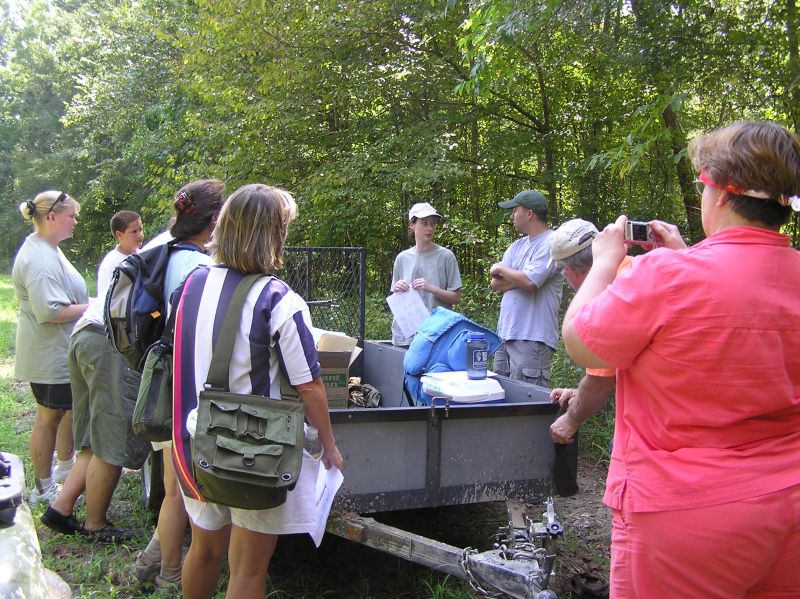
Sandy and Jun provide handouts and short lectures on the geology of the area.

General area where several crab nodules were found.
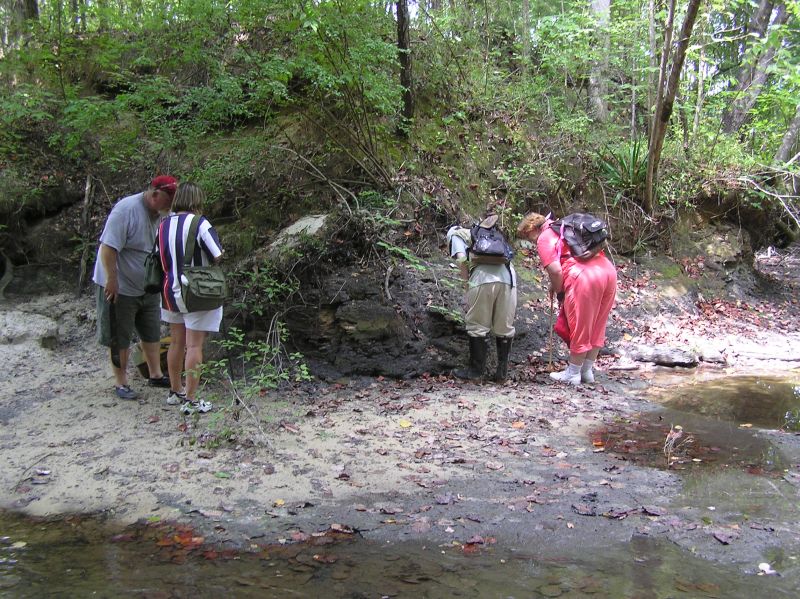
This outcrop has numerous small bits of shell and other material embedded in it. Sandy took lots of samples for her research.
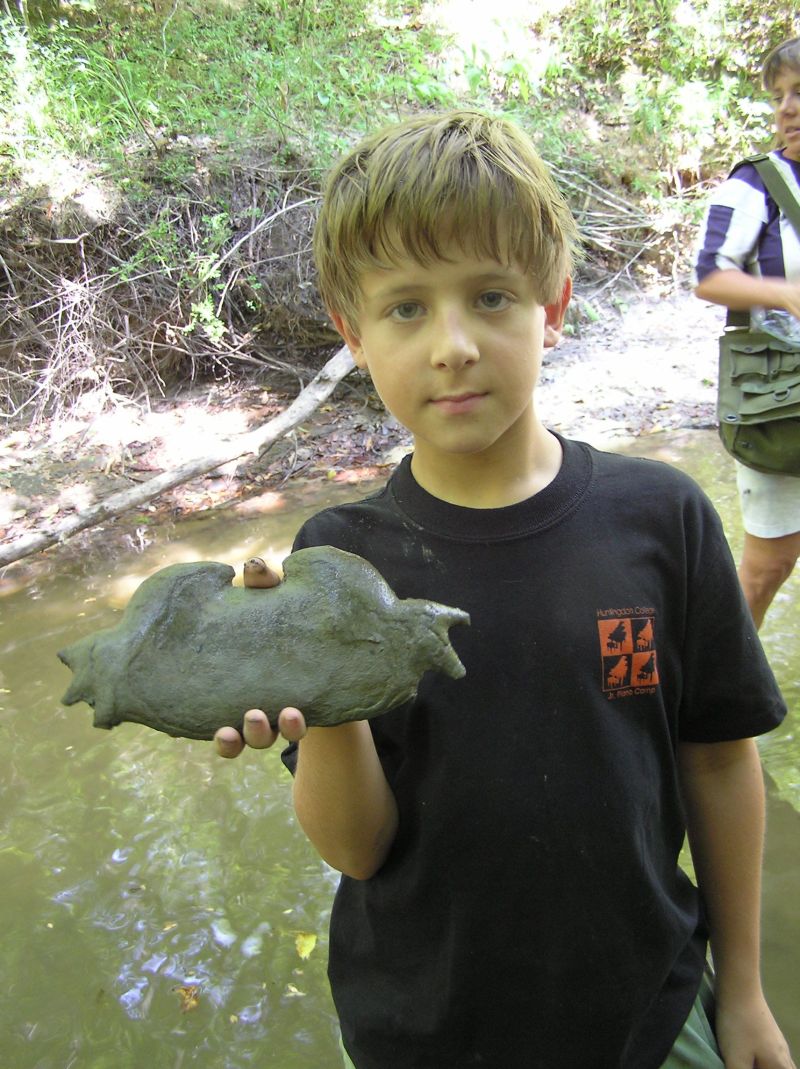
Richard found a very nice crab.

Leisa decides to sift the fine sand in her search for smaller fossils.
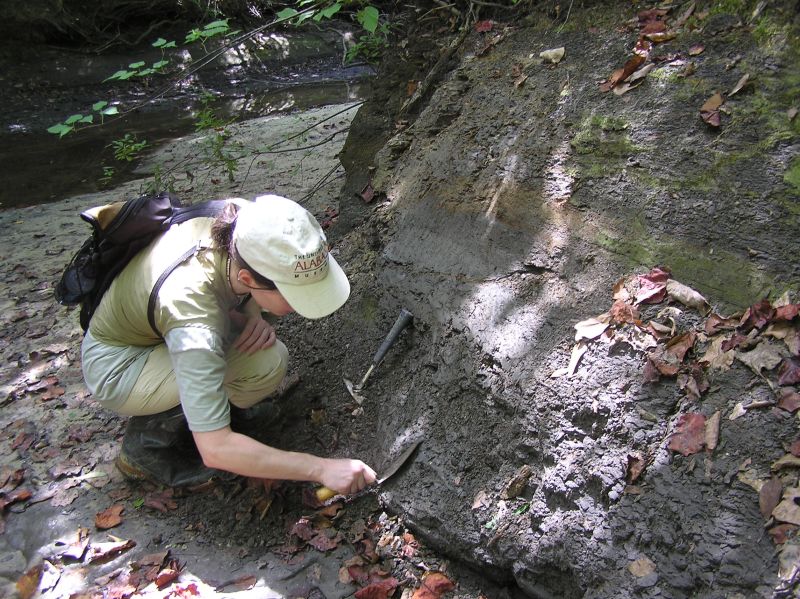
Collecting samples for research.
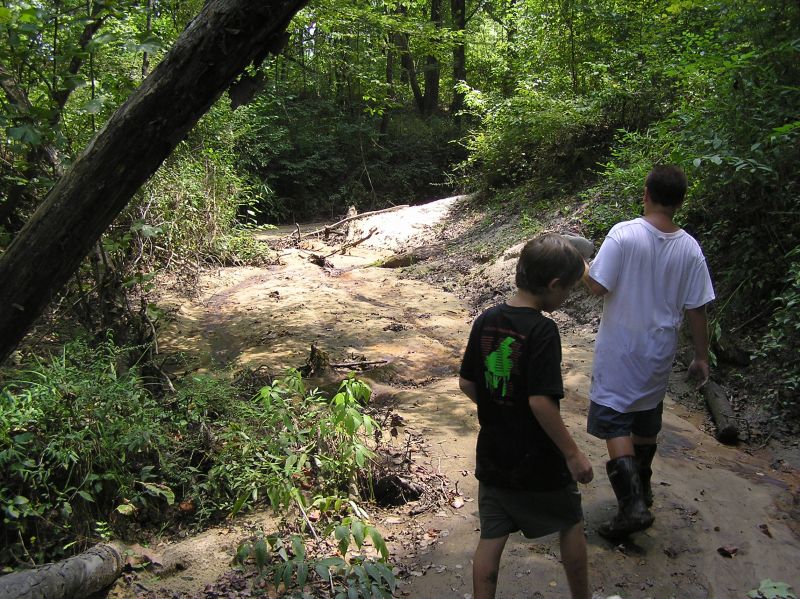
A dried up creek we explored in the area.
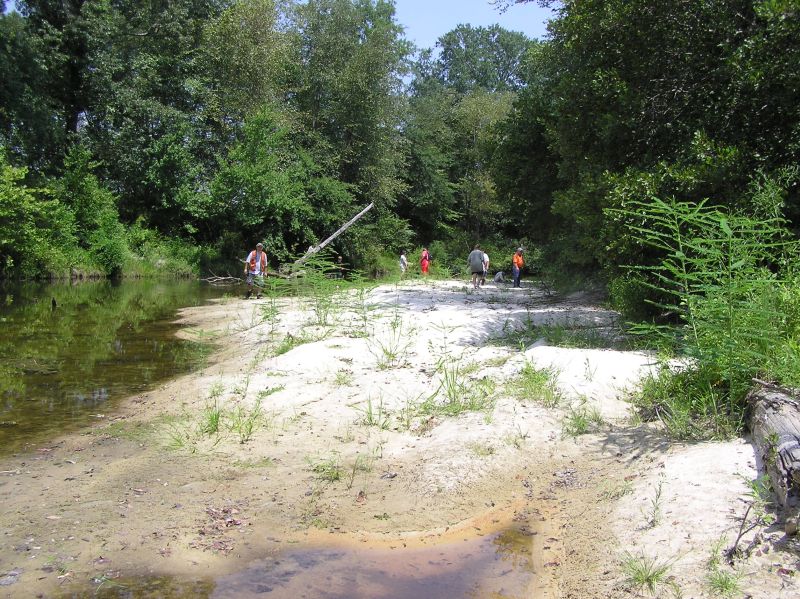
We explored the main creek a good long while.
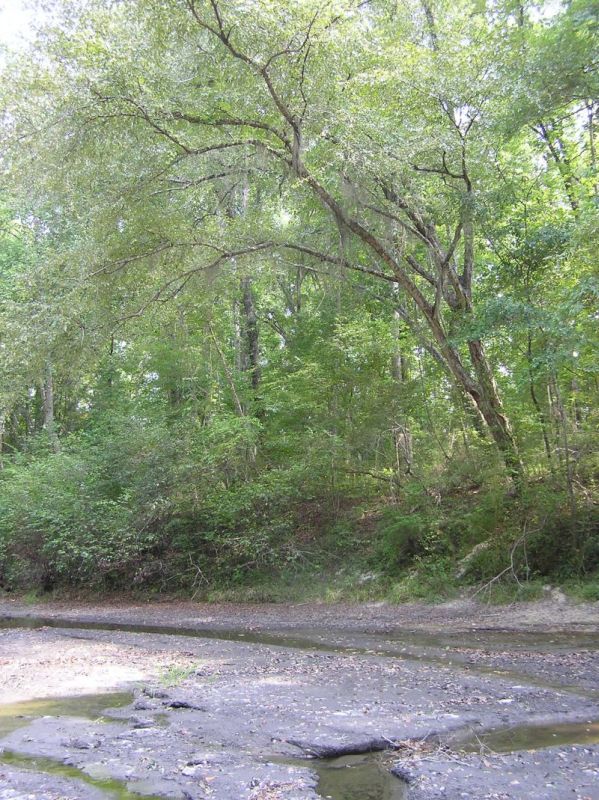
Nice view of the creek, which is almost dry in some areas due to the lingering drought. Notice the Spanish moss hanging from some of the trees.
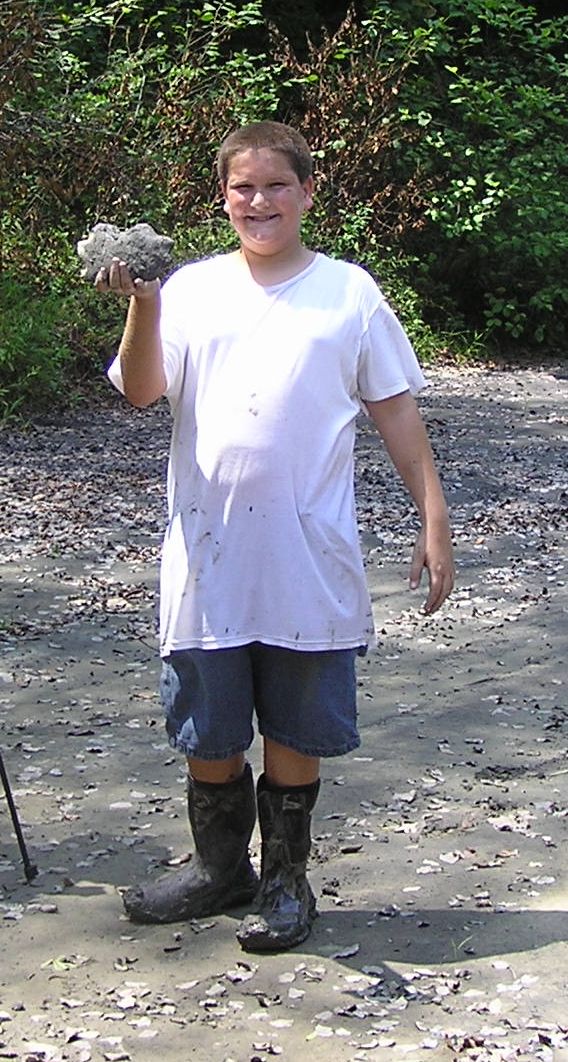
Aaron found a nice, large crab.
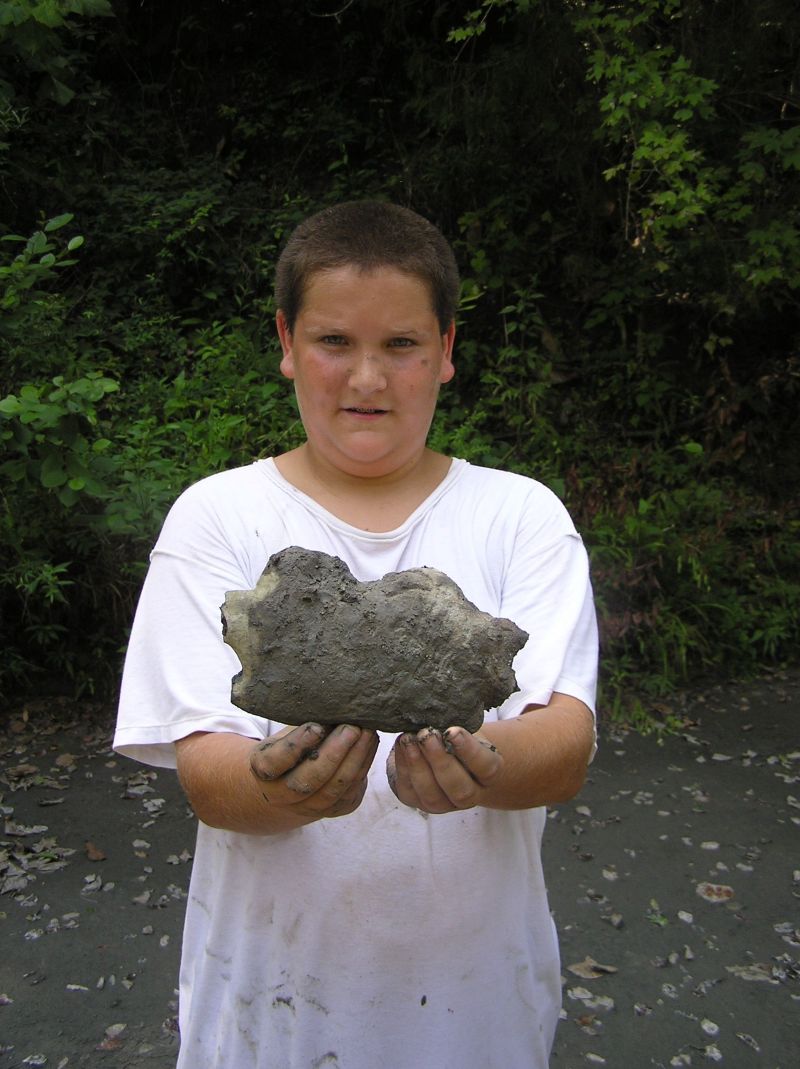
Closer view of Aaron's large crab nodule.
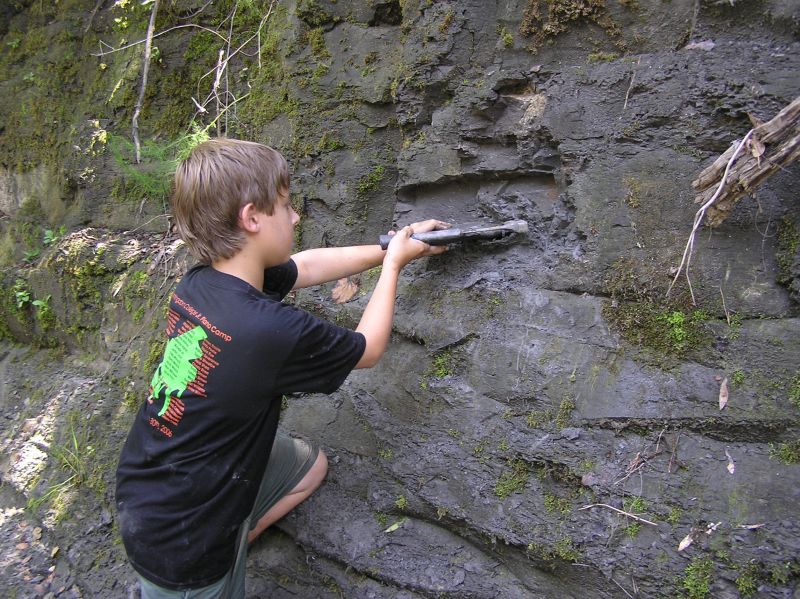
Richard is digging out a very nice crab.
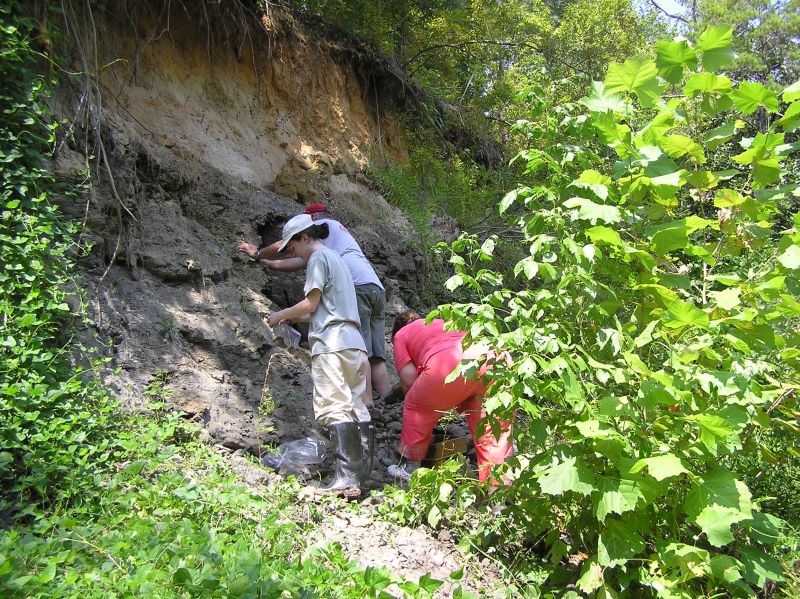
Another outcrop that Sandy found interesting. Many soil samples were taking from this location.
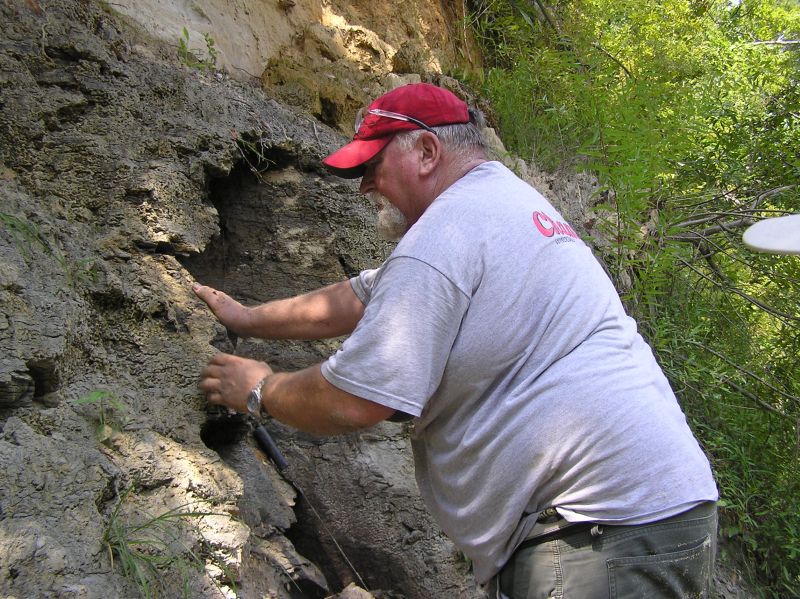
Greg is assisting in collecting the soil samples.
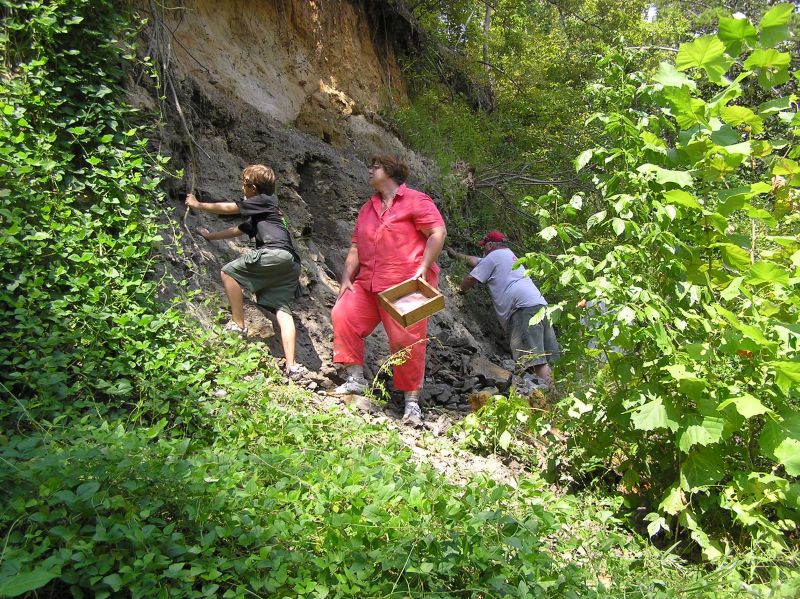
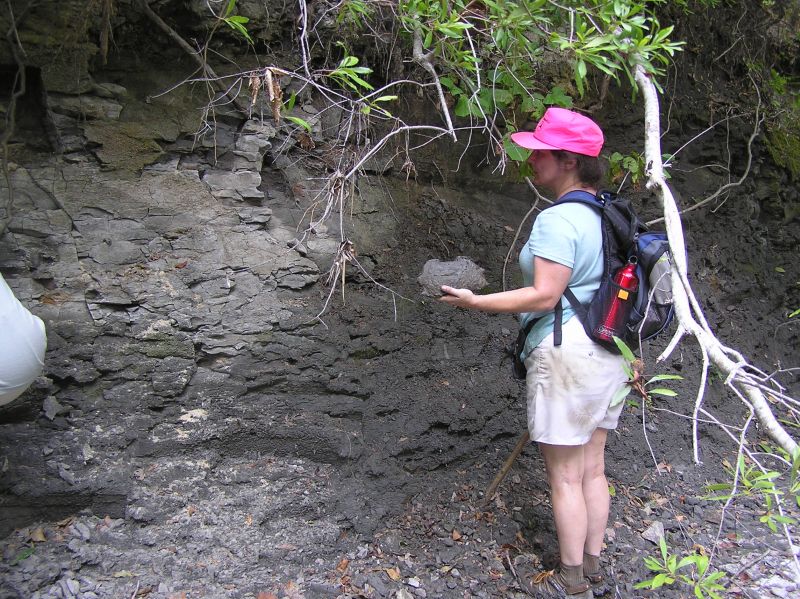
Becky found this nice crab nodule.

Michelle found part of an ammonite.
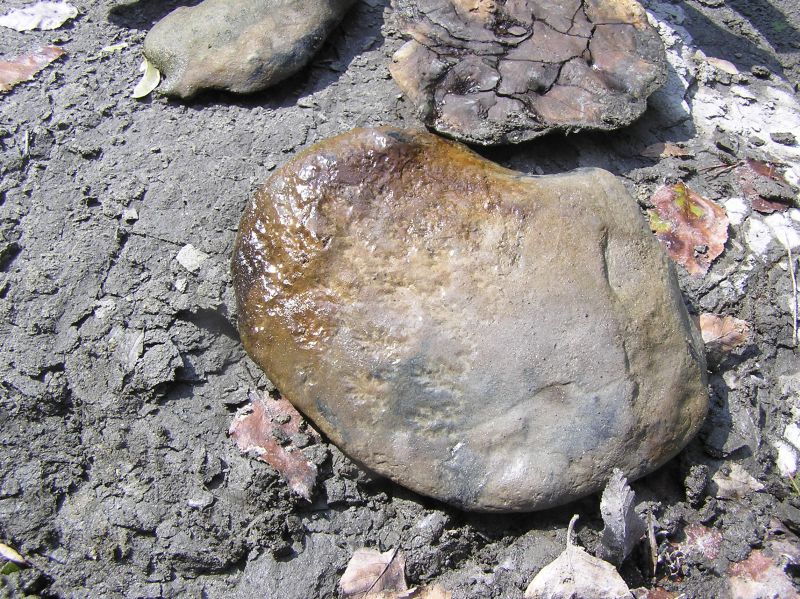
More ammonite found by Michelle.
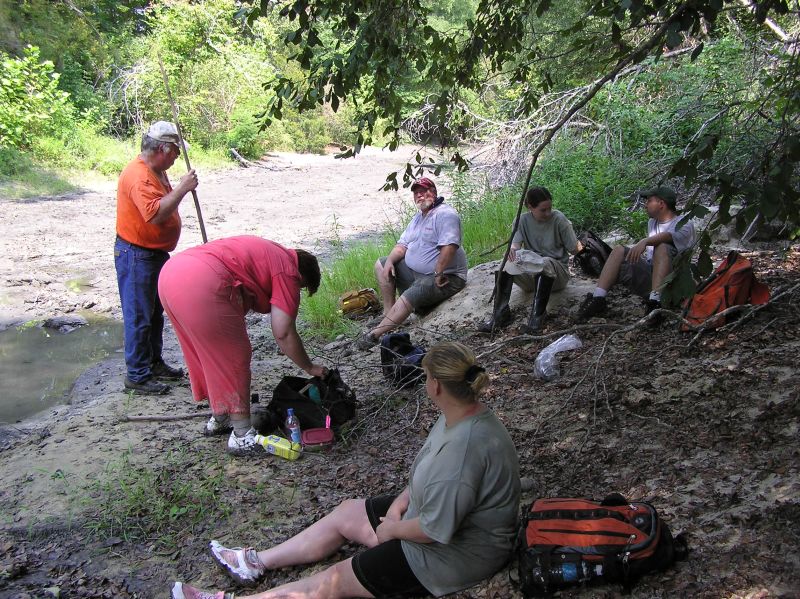
Taking a rest after a long, hot day on the creek.
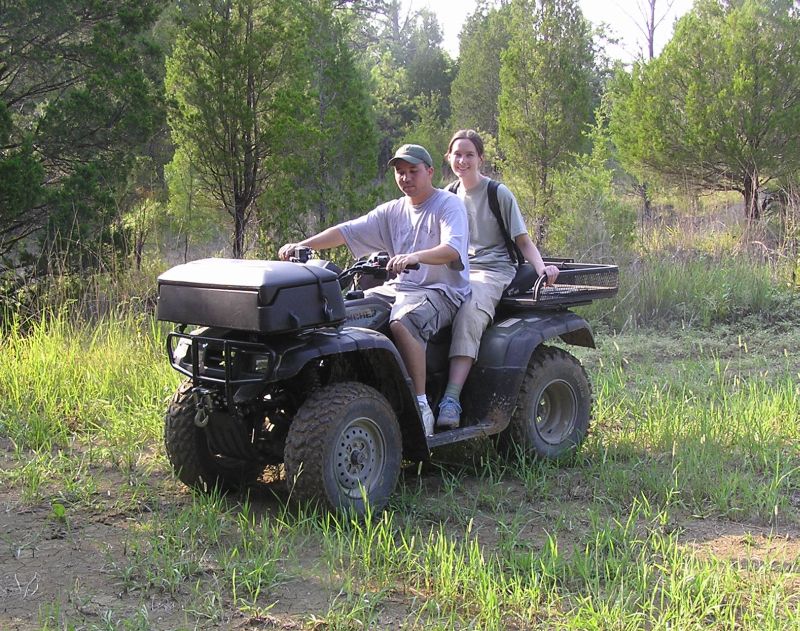
Jun and Sandy probably had more fun than the rest of us getting to the next collecting location - this was Jun's first opportunity to drive an ATV!
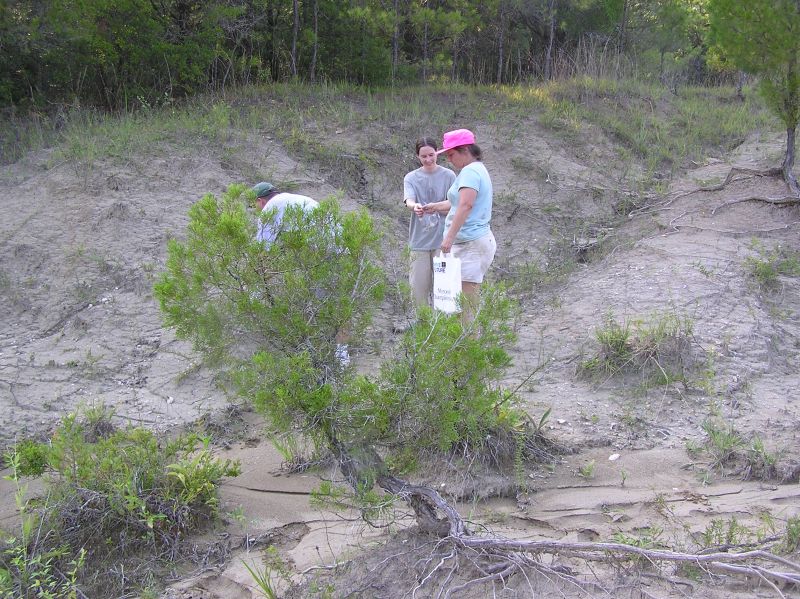
After a bit of a rest, we decided to explore a gully late in the afternoon.

This is how the gully looks when you get closer to the ground - a lot of shell bits and pieces. Can you find the shark tooth in this picture? It takes a while to get one's eye attuned to the coloring and patterns.
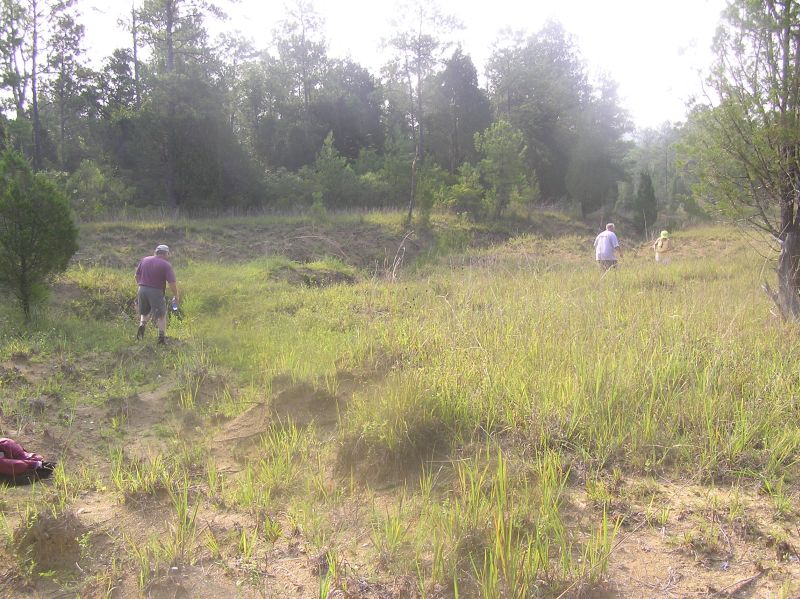
Early Sunday morning, we headed to a gully that had not been surveyed in several years. No items of interest were found here, mostly bits of shells and broken nodules, and a lot of caliche.
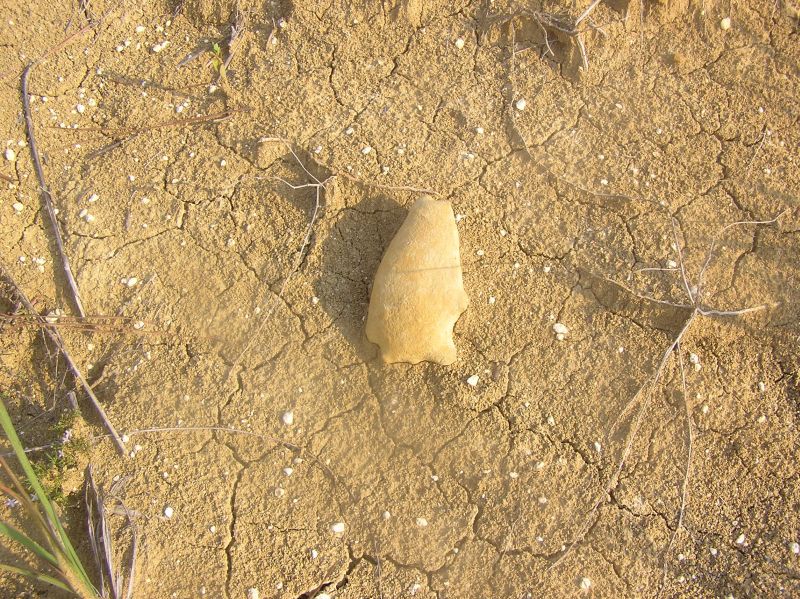
Closer view of the ground and a nodule.

After the gully trip, one group headed back to the main creek for crabs, and the Three Musketeers, Becky, Vicki, and Michelle, headed off for an adventure to find and scout a new creek.
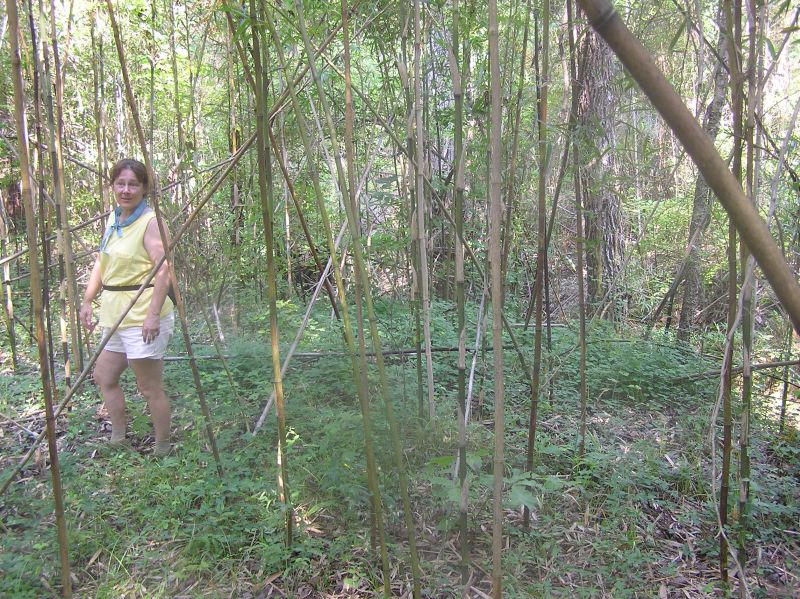
Becky amongst the fishing poles.
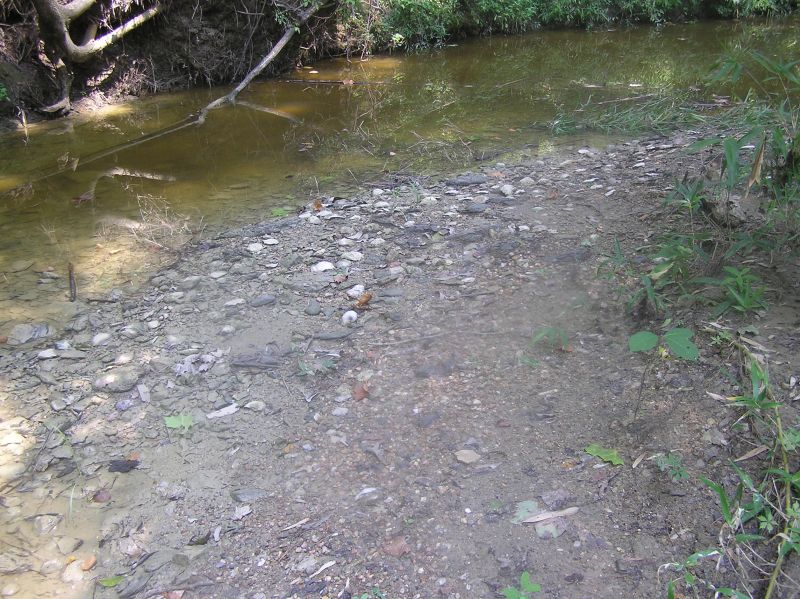
Finally, we made it to the creek, which was littered with shells, primarily exogyra.
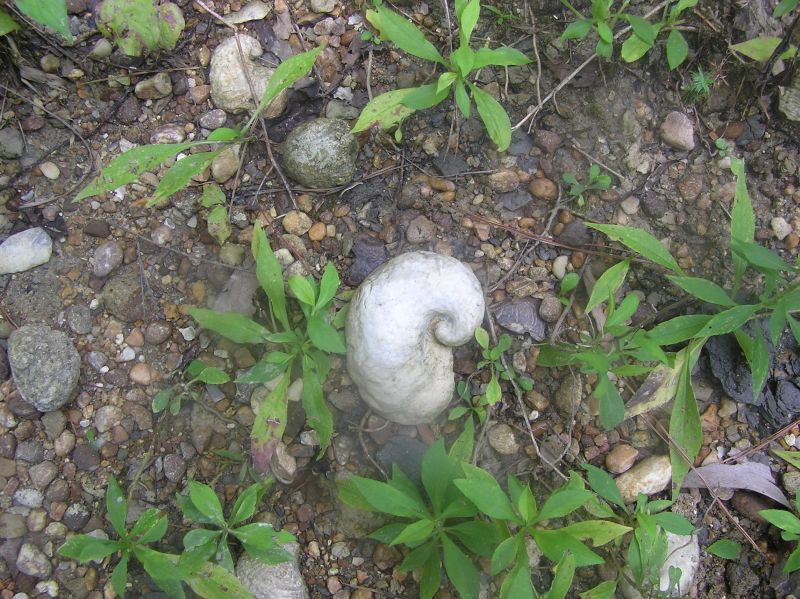
Exogyra.

More exogyra pieces. The slightly circular pieces with the dimple in the middle are the other half of the exogyra, though we did not find any articulated specimens.
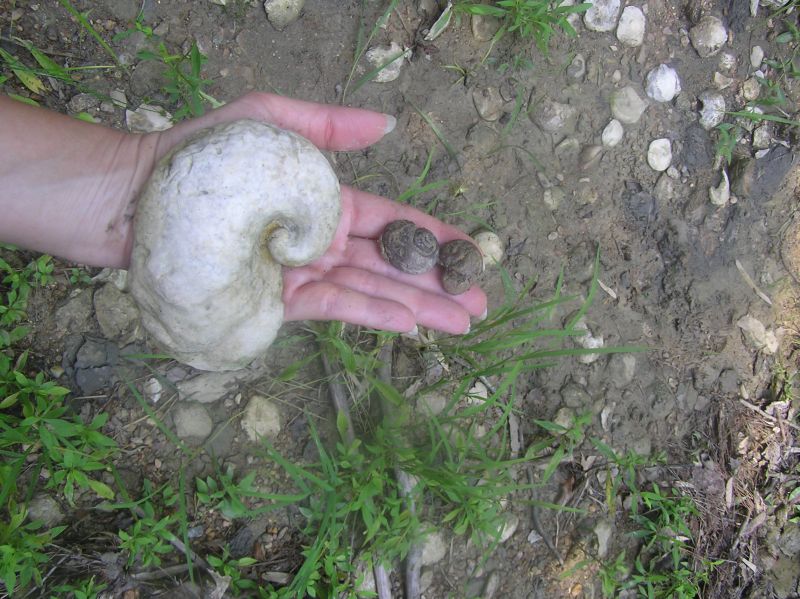
Exogyra and a couple of gastropods found by Vicki.
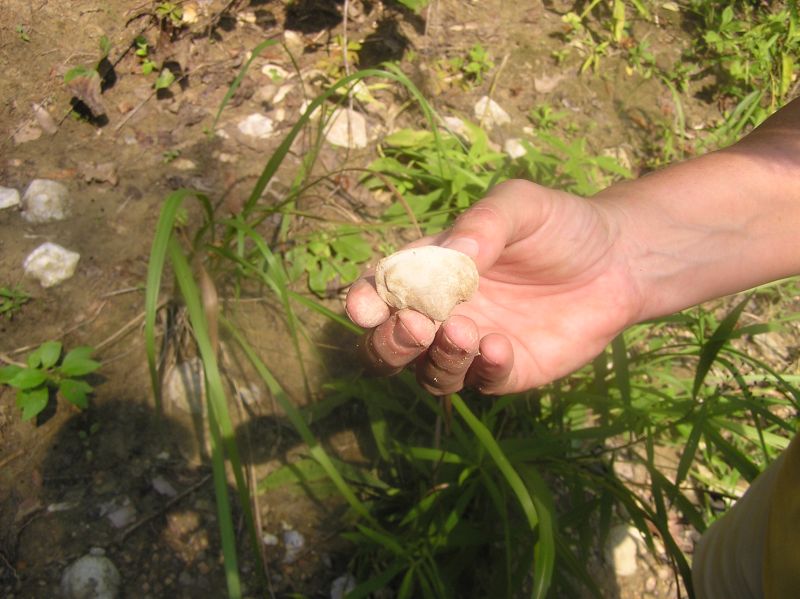
Nice bivalve found by Becky.
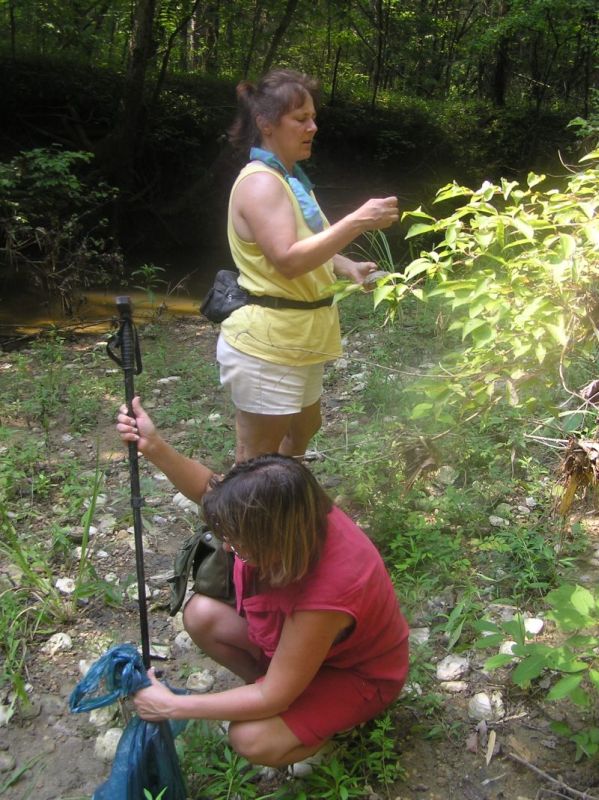
Michelle and Becky looking for fossils.
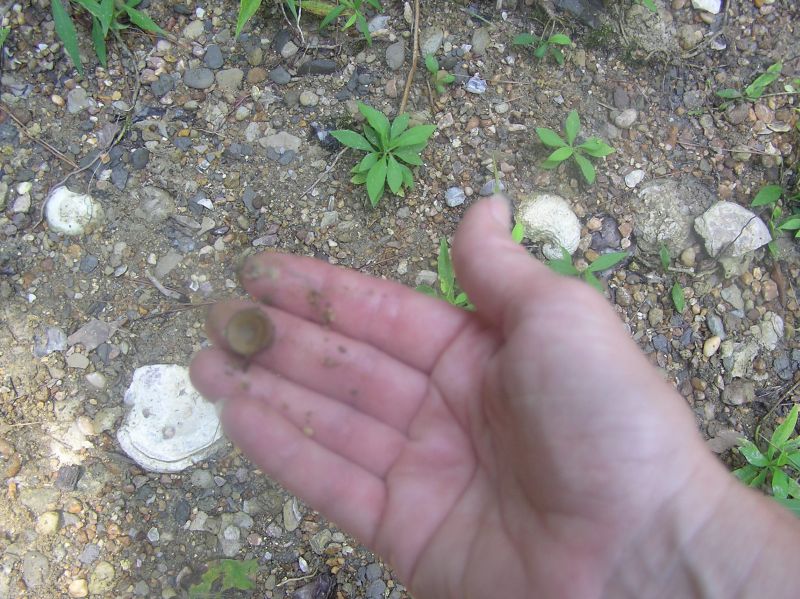
Small vertebra found by Vicki.
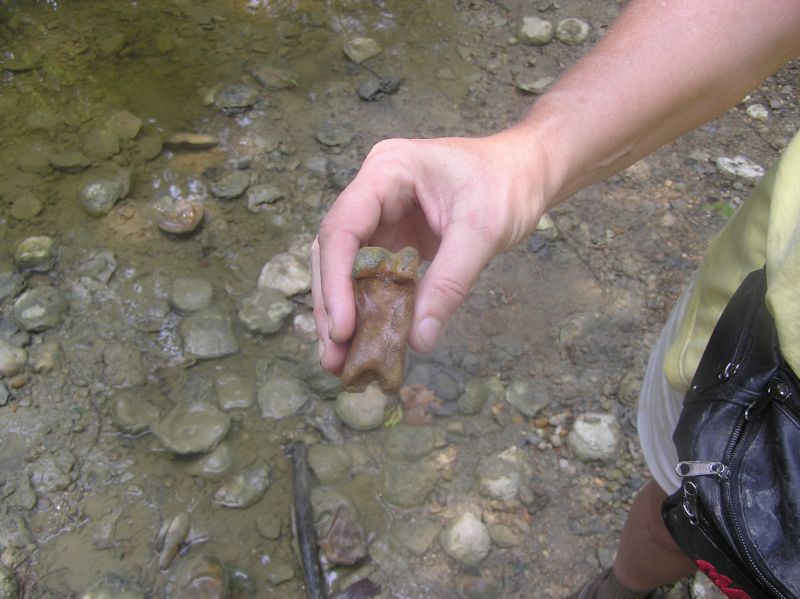
Bone, but unfortunately, it appears to be recent.
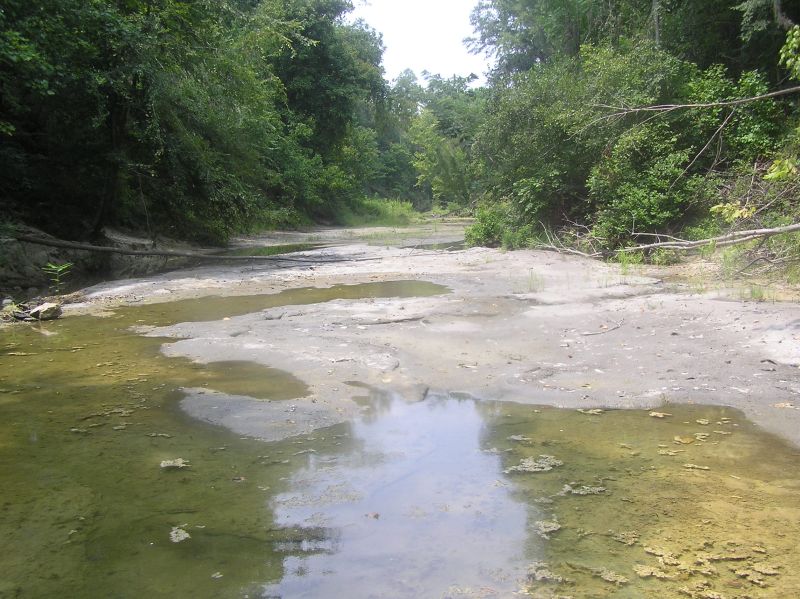
Last creek to be explored.
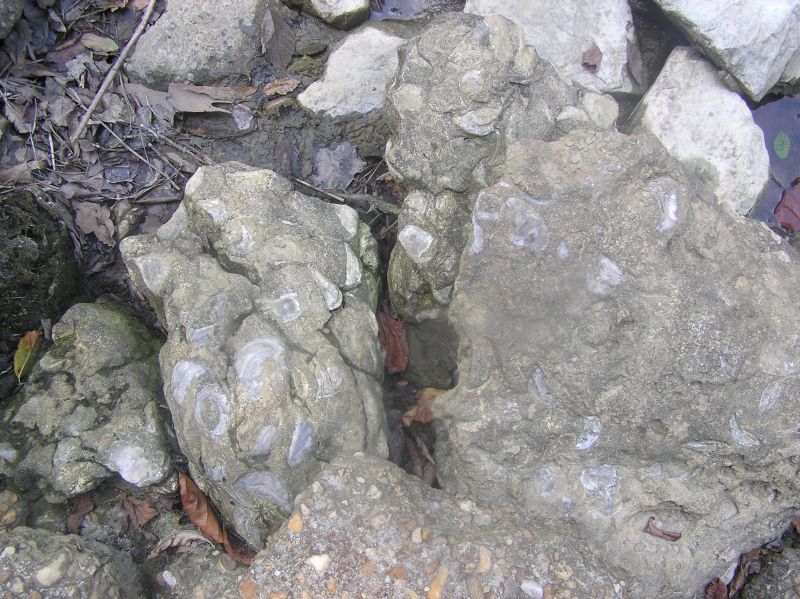
This rock filled with shells was found at this creek, but not much else, so all headed home.
June 24, 2006 - Cretaceous Fossils, Montgomery and Elmore Co, AL
A relatively small group of BPS members went to a creek in Montgomery County for today's trip - could it be some people were scared off by the thoughts of 95 degree weather in the sweltering sun? To get an idea of our weather, go to your bathroom, turn the shower on the hottest it will go, close the door so steam can build up, turn off the A/C, then take your laptop in there and view our trip photos - you will have a good idea of our day! Leisa brought her canoe, and she and Claire floated/pushed/dragged it upstream and then back down. This late Cretaceous site once again yielded numerous echinoids and ammonites, though most of the ammonites could only be "collected" via photos, due to their fragile composition. We also found huge quantities of shells, a few shark teeth, a couple of mosasaur vertebra, two large vertebra, possibly shark, and pyritized coprolites.
Several people decided to call it a day after getting too hot for comfort. After a refreshing afternoon lunch in an air conditioned restaurant, the die-hards brains began coming up with another potential collecting site in Elmore county. Since we have a canoe, lets go look for petrified wood. Now understand, we had one canoe, one paddle, 3 life jackets and 4 people to go on this escapade. After a quick stop at the local discount store for an additional paddle and PDF, we scouted access points. The put-in we decided on was steep. Really steep. Really really steep. But we finally got it down the several hundred feet to the water, only to find a boat wasn't necessary, the water was low, the shore was easily walkable, and petrified wood was everywhere. So we collected it (ask Jan how much his pack weighed!), took some pictures of a tree that was about 4 feet in diameter, and noticed it was getting darker. And windy. And there was thunder. And lightning. And lots of cold rain (boy, did it feel good!) And we had the canoe at the bottom of a huge hill. But Leisa, resourceful as ever, had a plan; just hook the boat to her van, and pull it out.
(photos courtesy Vicki Lais)
So we "park" the boat, and go along the bank collecting large pieces of petrified wood. The weather is getting ominous. The wind is picking up, we hear thunder and see rain off in the distance. But we just got here, and we've got to get that boat back up the steep slope!
Wow, looks like we may have to come back to get this one, it won't fit in the canoe . . . .
Some echinoids and shark teeth from Vicki's bag. About 2pm, we were so hot, we needed a break from the heat, so a small group met at a nearby restaurant to cool our brains. And we decided to go check out a river site since we had the canoe.
I knew it, I knew it, I knew it, look what they've gotten me into now! Just getting started up the steep bank. Worn out from the distance already covered, and soaking wet from the recent rain shower. But it was fun, and we had our adventure for the day!
Look carefully and you can see several shell impressions in this rock, along with some shells scattered in the dirt.
Shells and echinoids in matrix. These rocks are pretty hard, so these were left in place.
Melanie found a nice gastropod in the same area where the tiny shark teeth were found.
Tree trunk breaking into pieces on the bank. Numerous pieces like this were scattered everywhere.
First we need the canoe way down the bluff to the river bank so we can paddle downstream. Well, now wait a minute. This river has always been much higher, all the way into the weeds, and you couldn't walk here, summer nor winter. What's going on here? We don't need the canoe after all!
Leisa very quickly found a nice vertebra. After collecting the vertebra, Leisa and Claire headed up the creek, and we didn't see them again for several hours.
Claire has found a couple of shark teeth, one still embedded in the rock matrix.
Not sure what this is, shaped like an ear bone, but looks like pottery, very smooth and obviously supposed to be shaped this way, not very worn looking.
Claire also found a pile of sh#!, um, well, or rather, a bag of pyritized coprolites!
Jan is wondering just exactly how we plan to pull this off. Perhaps he made a hasty decision to come along, as the others didn't seem to be giving any thought to the difficulty of what we were proposing. The river is down an extremely steep slope.
- ‹ previous
- 3 of 4
- next ›
May 6-7, 2006 - Cretaceous Fossils, Lowndes Co, AL
This May found the troops encamped in Lowndes County for a whole weekend of fossils and good company. Tents, camping vans, pop-up trailers all turned out for the great weekend of food, hunting and sleeping out thanks to the generosity of the hunting camp. Our hosts supplied rides out to gullies and a creek on their property via ATV’s and trailers. Even Sylvie made the bumpy ride out to the creek, although some of us did do a quick, quiet poll as to who knew how to deliver a baby or how long it would take to make it to the nearest medical facility, JUST IN CASE she hit one bump too many! We had a great crowd, and some excellent specimens of fossil crabs, shells, ammonites and various teeth were found. After a long day of collecting, we gathered around a roaring fire for a low country shrimp boil and good conversation. Everyone seemed to be demonstrating that everything does taste better outside! Michael and Sylvie had left early, Sylvie declaring that she was now ready to go home and have a baby!
Even the rainstorm that burst on us Sunday morning didn’t dampen spirits. Sleeping with the rain pounding down while you are warm, dry and cozy is one of life’s lovelier experiences! The early risers gathered under one of the many “porch” shelters in the camp and revved up the little propane stoves to make breakfasts of pancakes, cereal, coffee, tea...all the comforts of home, but more fun. Finally, all but the most dedicated decided to call it a day and head home. Nancy left a few of her belongings behind, so Vicki and Martha decided to return them via Selma, wait out the storm and do a little more looking around before heading back.
It was great to see so many of us, old and new members AND guests, turning out for all or most of the weekend. THANK you to our hosts for making us feel so welcome and providing all the facilities. Also thanks to our hosts, and to Shannon and Jim for providing vehicles and trailers, and to Vicki and everybody who helped organize the weekend and the shrimp boil!
This month we were collecting in the Ripley Formation, Cretaceous Period, Maastrichtian Age. According to information published by George Martin, Soil Data Quality Specialist with the USDA, most (if not all) of the crabs found on the trip are Avitelmessus grapsoideus Rathbun, or “Muffin Crabs.” These crabs have been documented from the Ripley Formation in Alabama, Mississippi, and Tennessee. Along with crabs, members also found numerous teeth, including mosasaur, sawfish, swordfish, and various types of shark teeth. Also found were numerous shells and pieces of ammonite.
--Edited by Vicki Lais
(Photos courtesy Jan Novak and Vicki Lais)
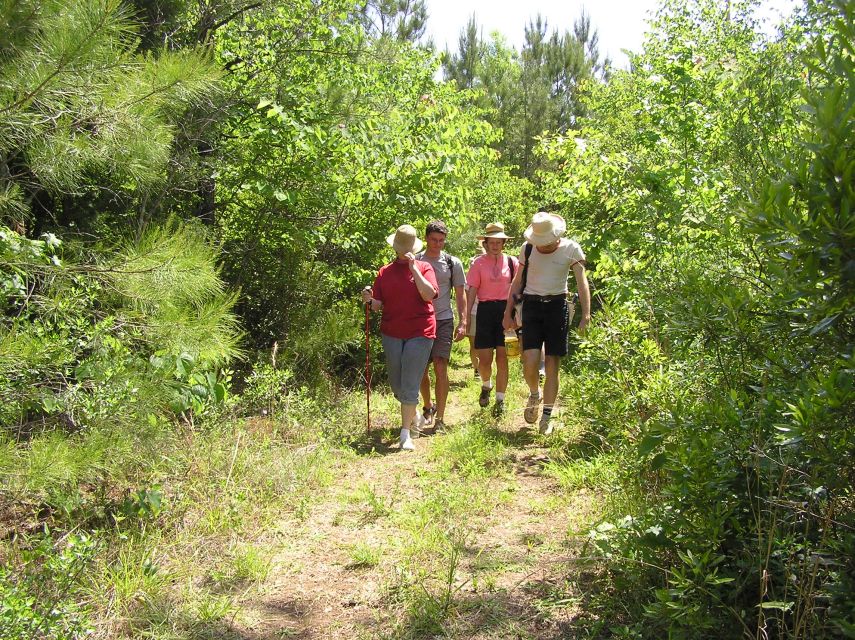
A long drive by ATV, then a short hike to the gully.
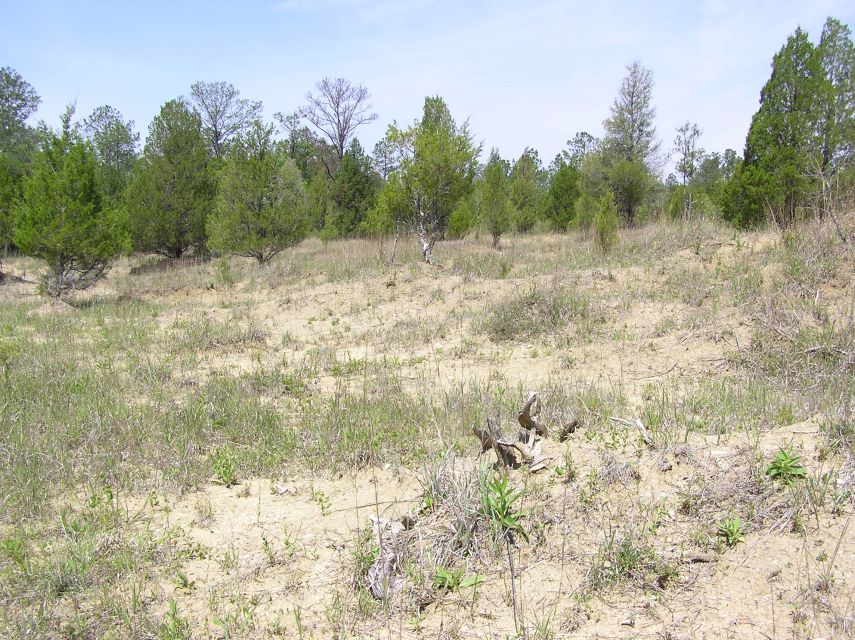
The gully where we began the day.

Greg has just given instructions on "how to collect in a gully", so everyone is being very cautious and searching carefully.
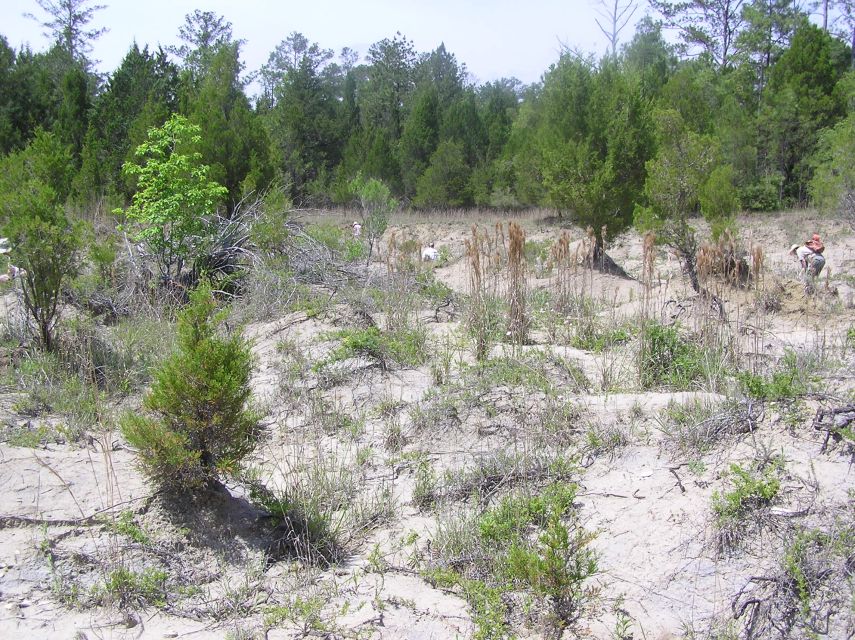
This is a rather small gully, with very little chance of getting lost here. Gullies in the Ripley are very unusual.
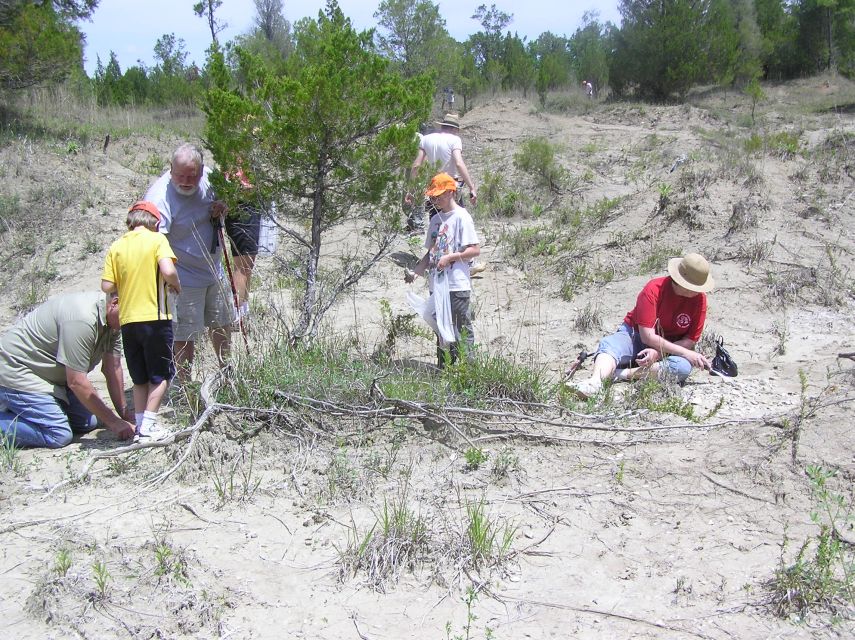
Sometimes it was easier and more productive to just sit in one spot and let one's eyes get accustomed to the patterns.
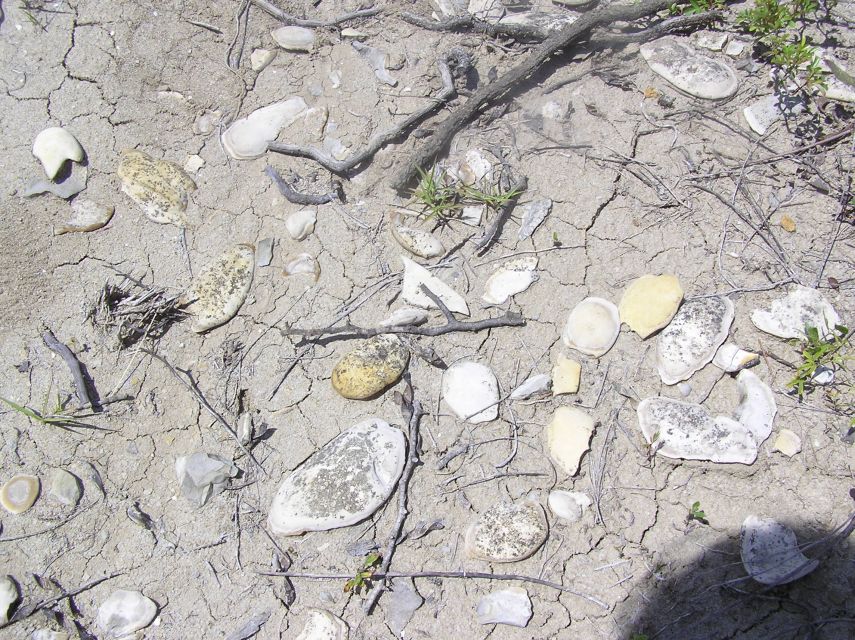
The gully is littered with numerous pieces of broken shell, nodules and sometimes fish and shark teeth.
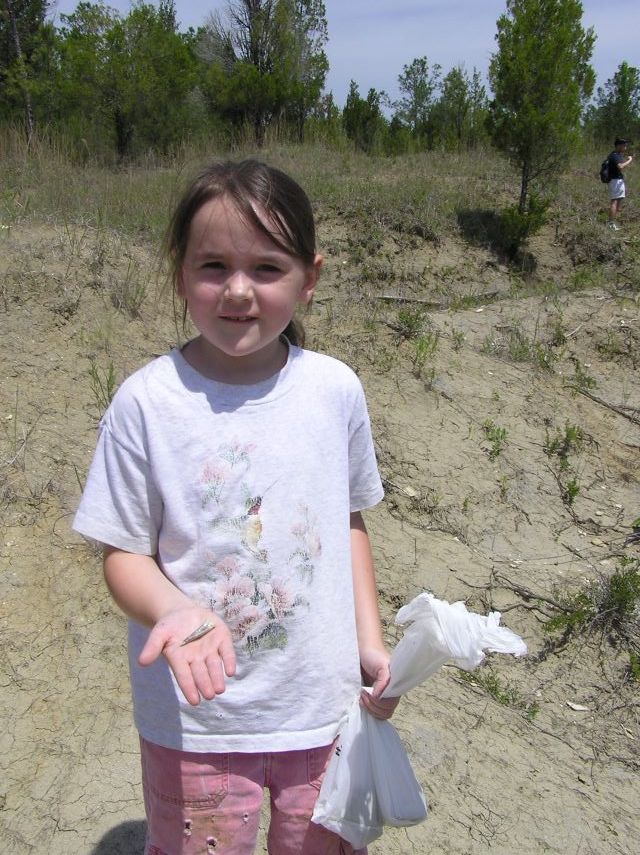
Loni's grand-daughter has found a sawfish tooth.

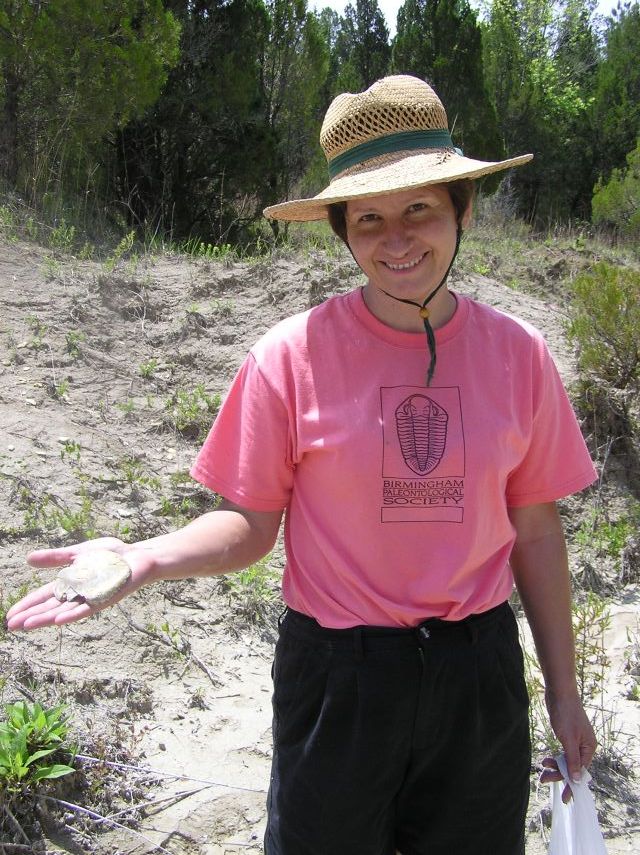
Lea has found the bottom part of a bivalve, possibly exogyra.
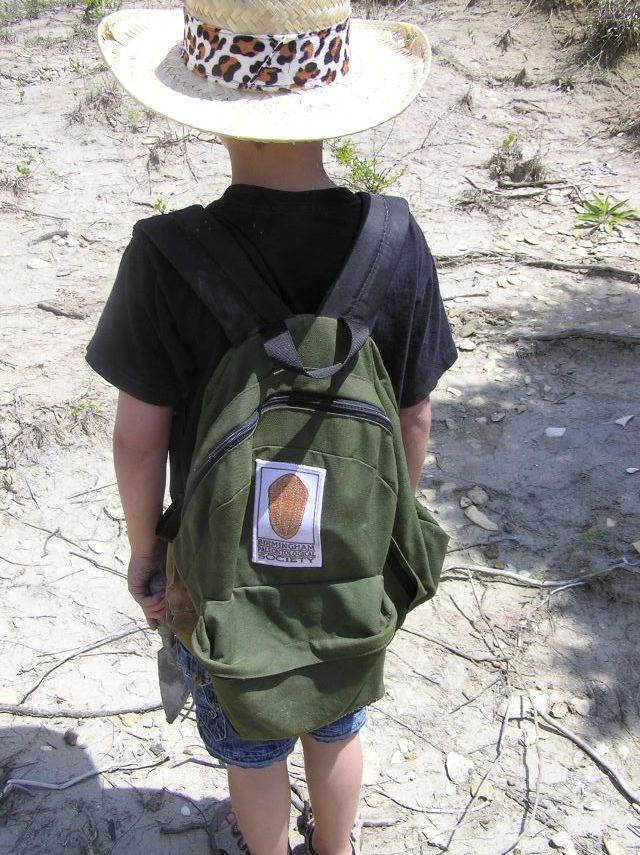
Shannon has found a new use for our logo patch - his son John's backpack.
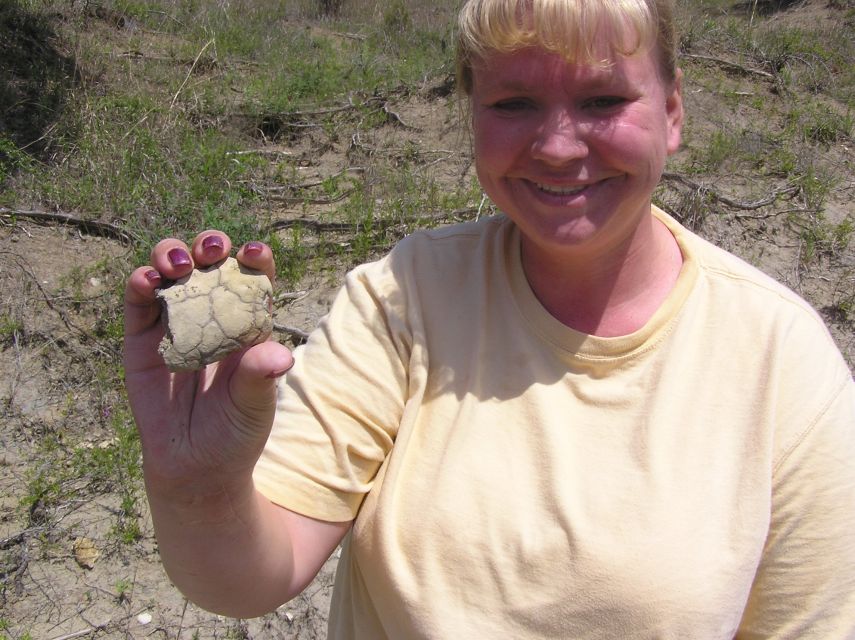
Melanie has found . . . something . . . .
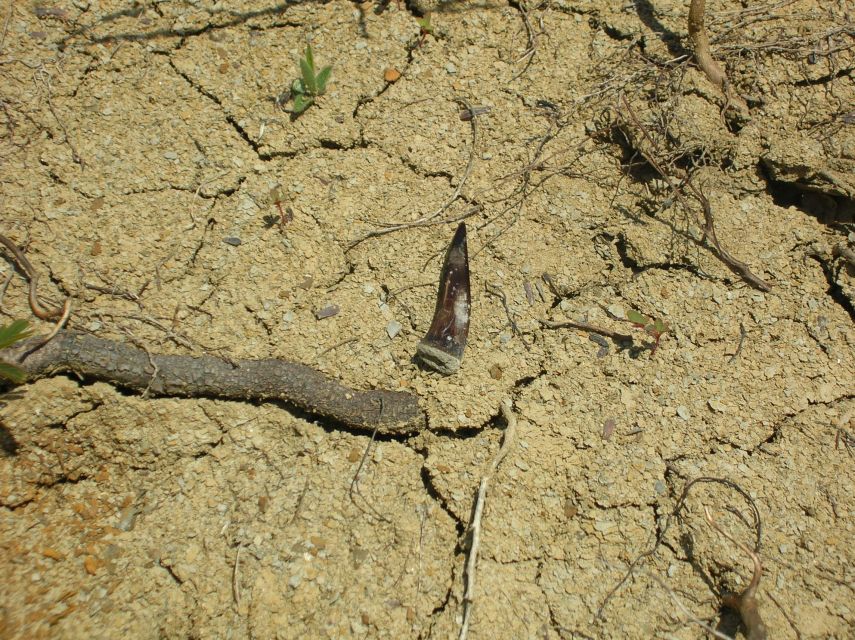
Tooth from a late Cretaceous swordfish, probably Protosphyraena.
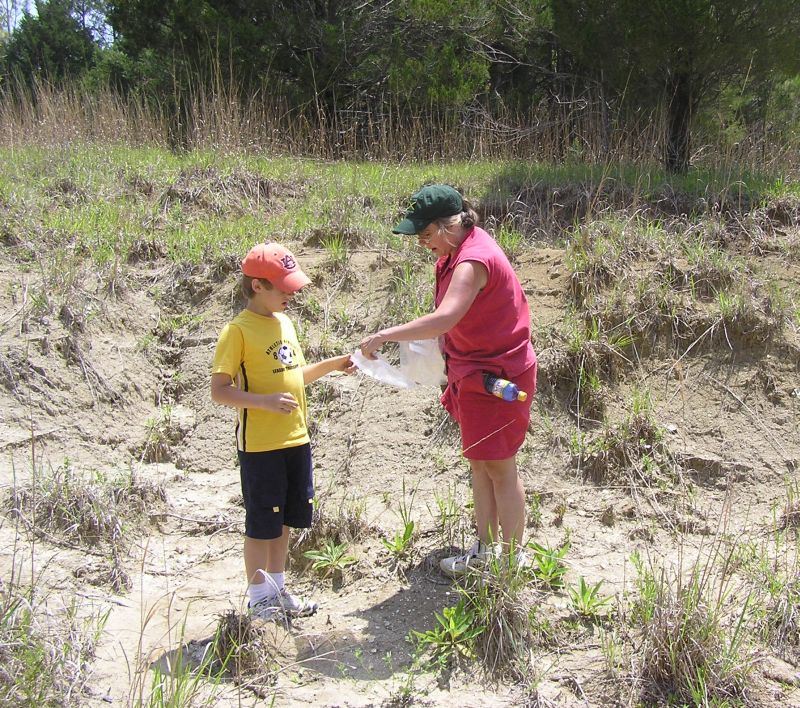
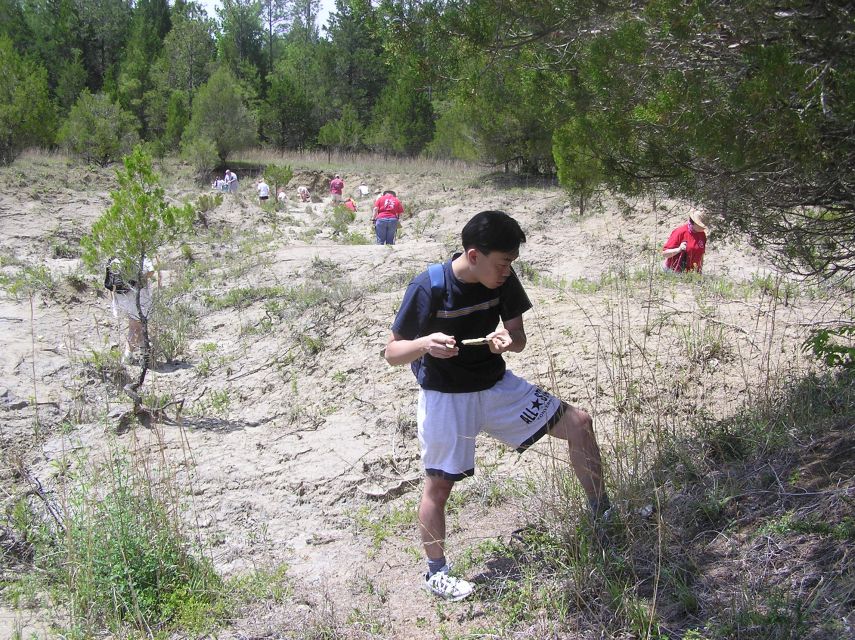
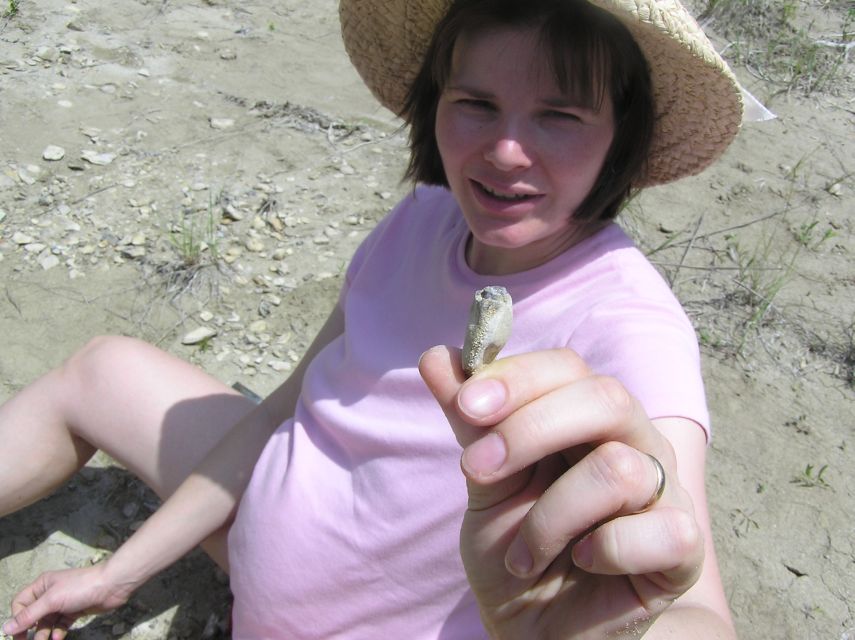
Sylvie has found part of a crab leg.

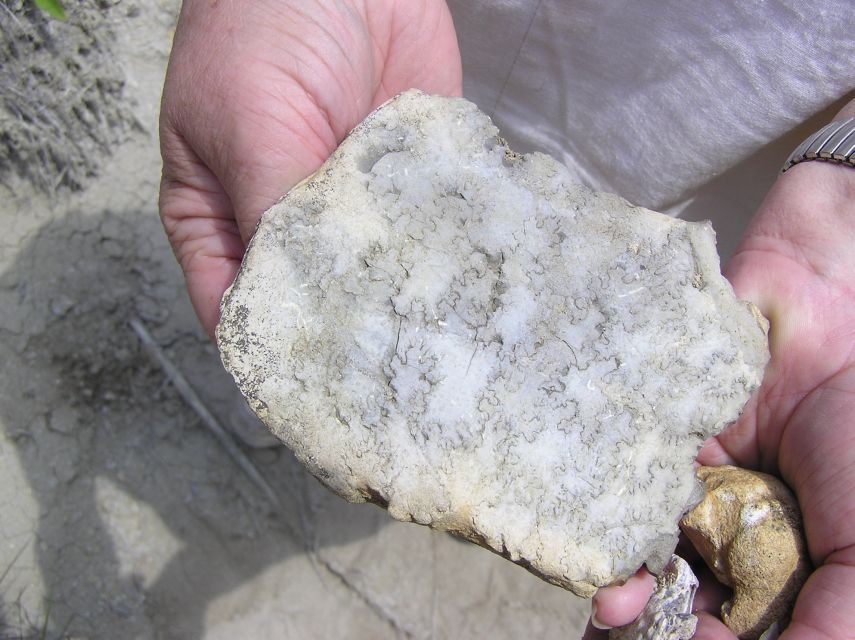
Small fragment of ammonite showing the tell-tale intricately patterned suture marks, which distinguish it from a nautiloid.
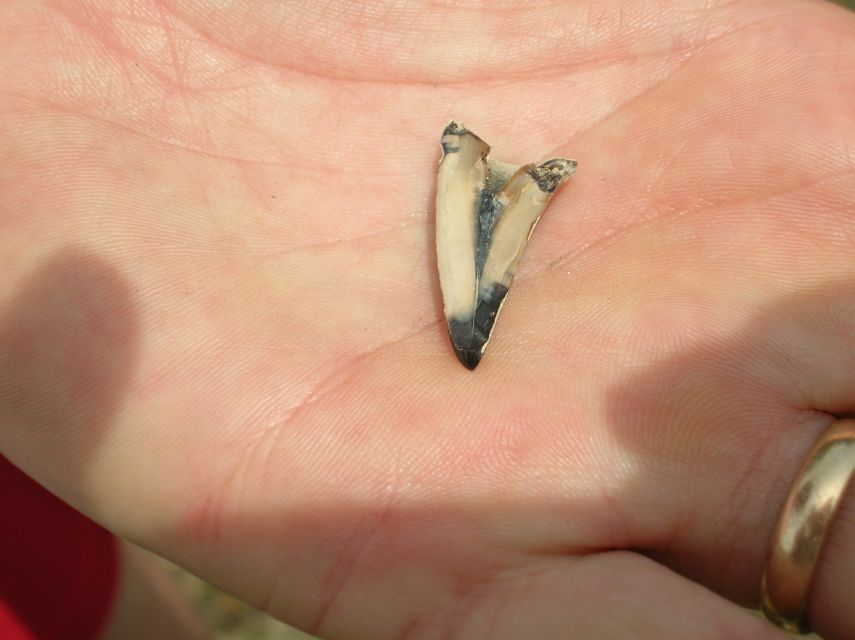
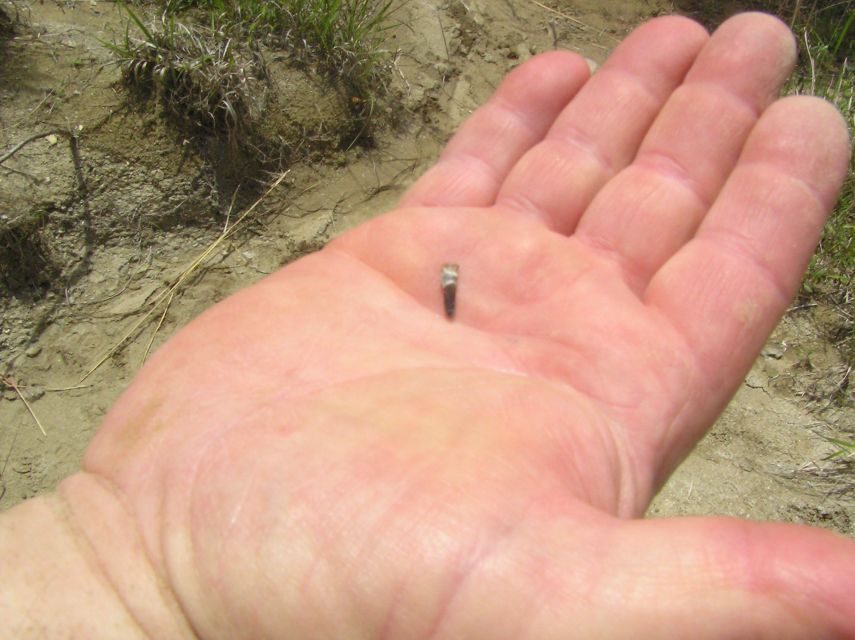
Mosasaur tooth.

A variety of shark teeth, and the long upper left one is a swordfish tooth.
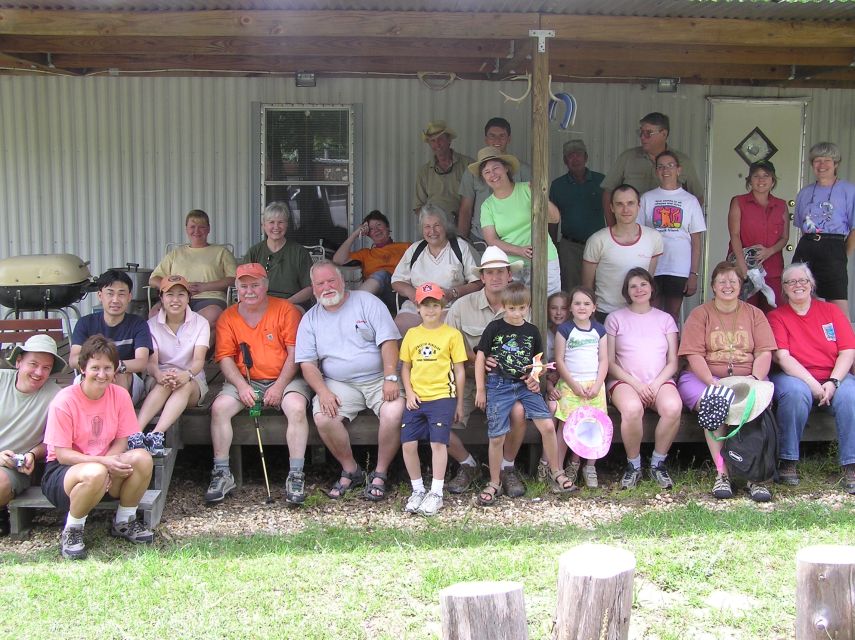
After a really hot morning, we returned to camp for lunch and a group picture. Uhh.... where's Claire, did we leave her??
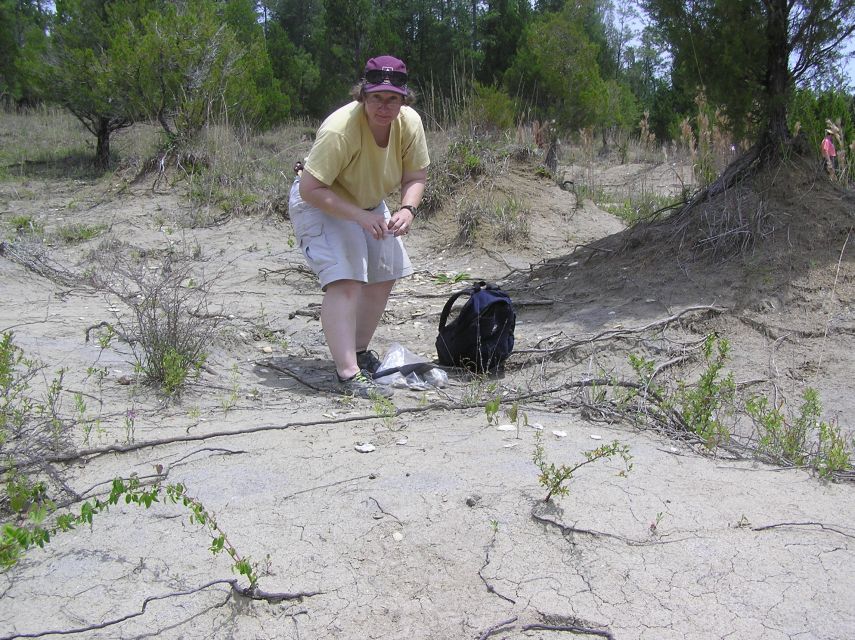
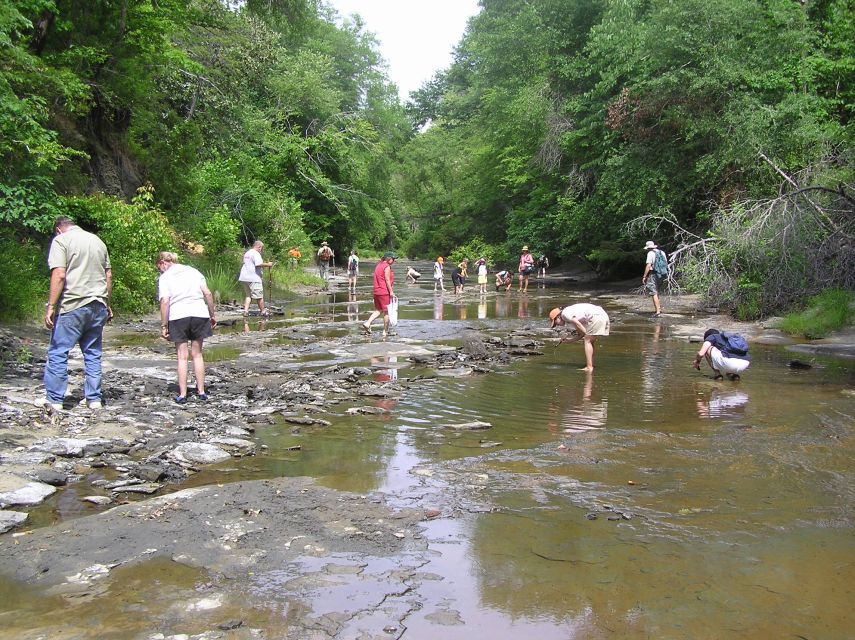
Members spread out to search the creek bottom and banks. Some go upstream, some go downstream.
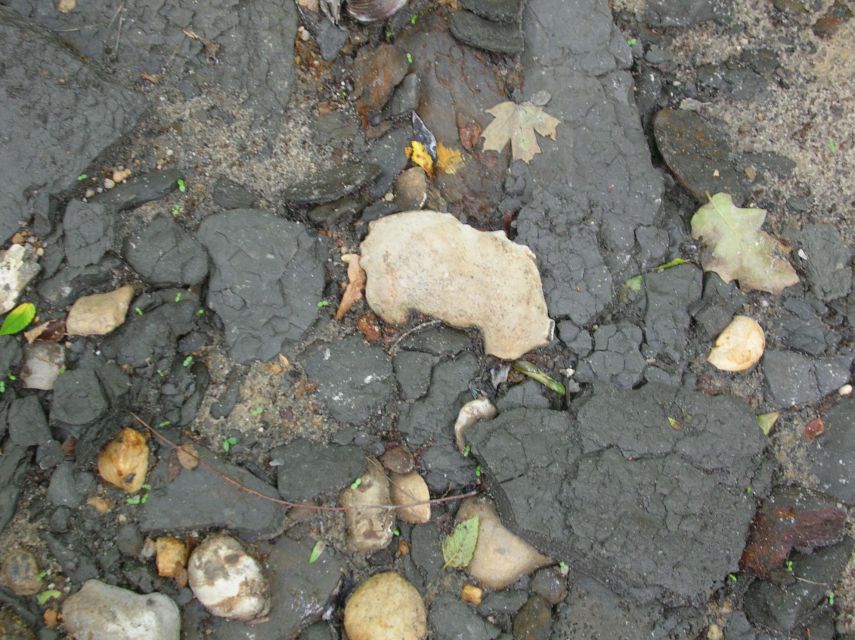
Nice crab. Note the dark gray clay. It is quite slippery in the creek and along the shore.
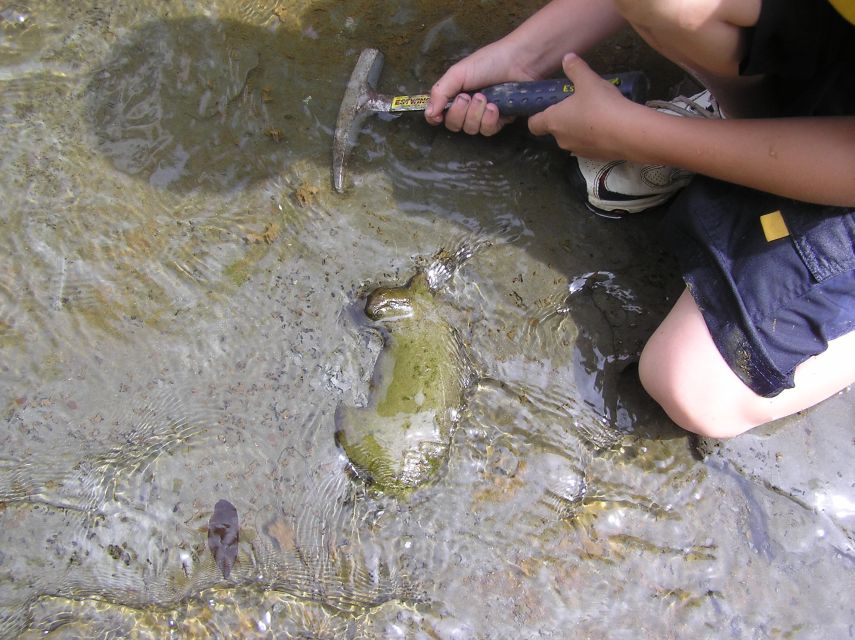
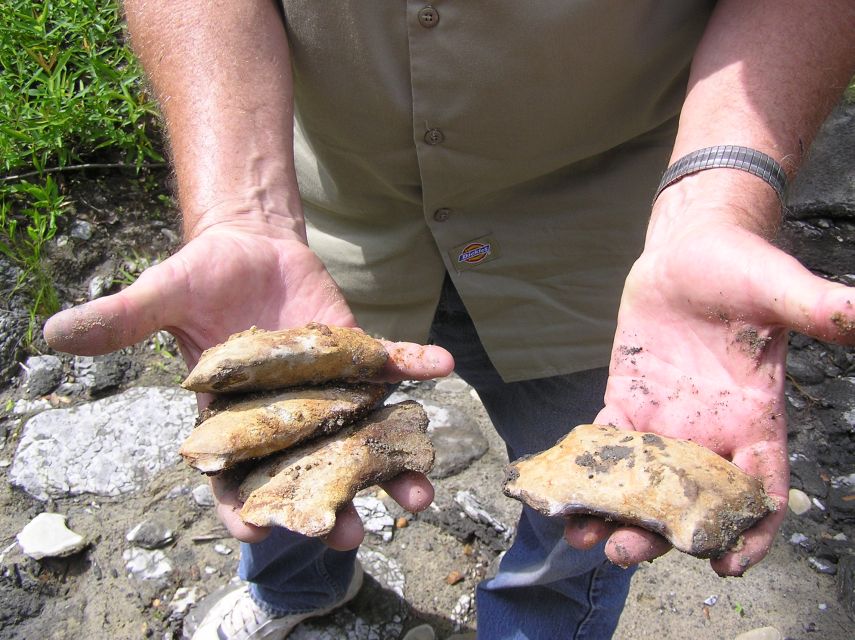
Some nice crabs.
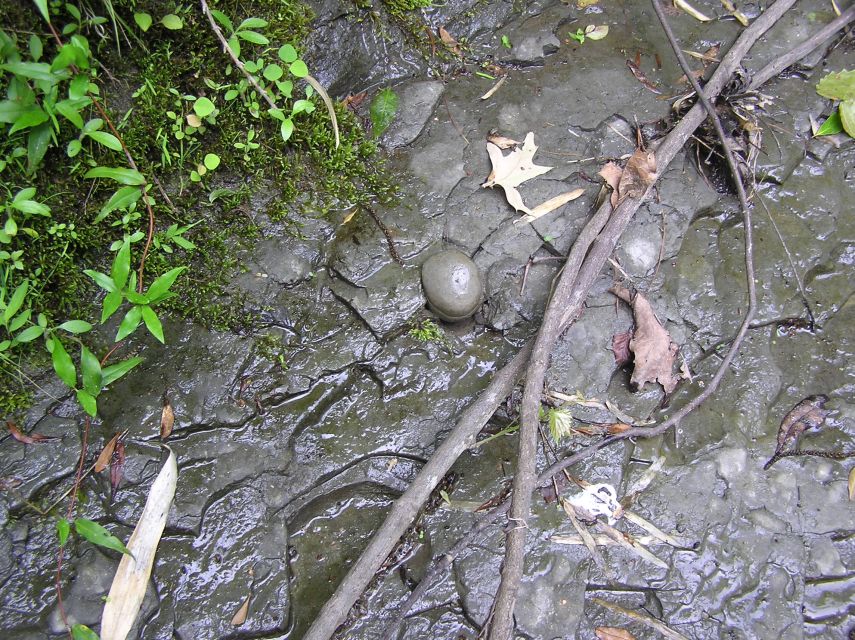
An odd round item found by Vicki.
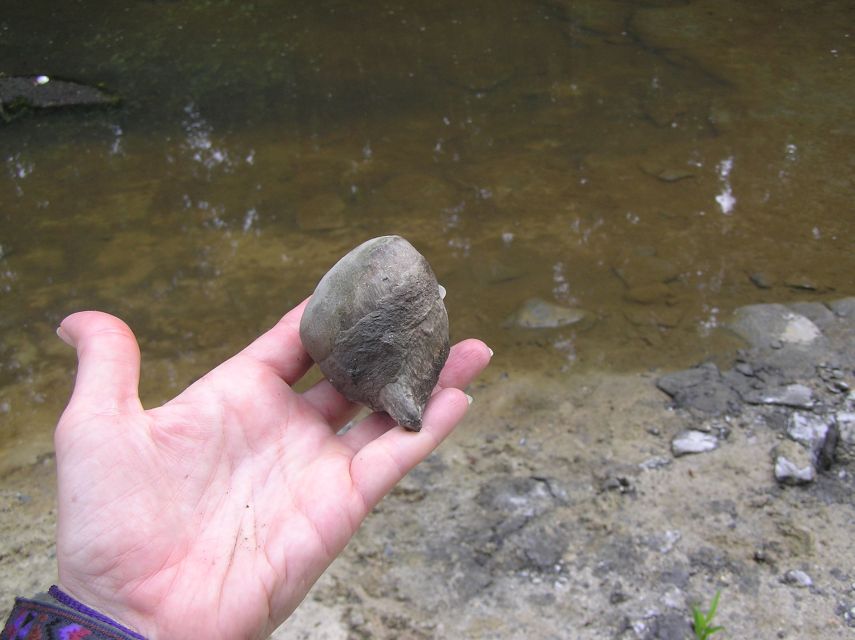
A closer look at the "round thing".
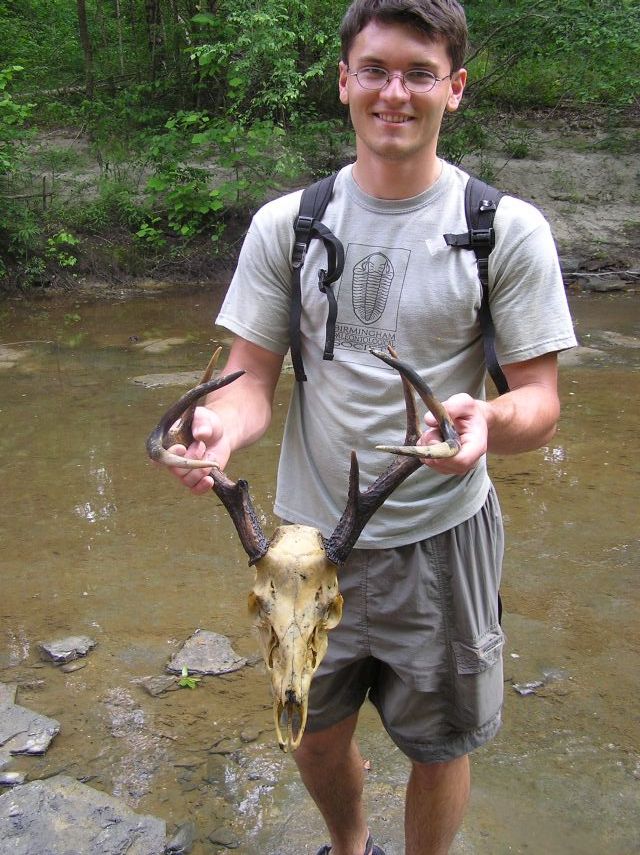
Rychard has found a nice deer skull, recent, not a fossil.
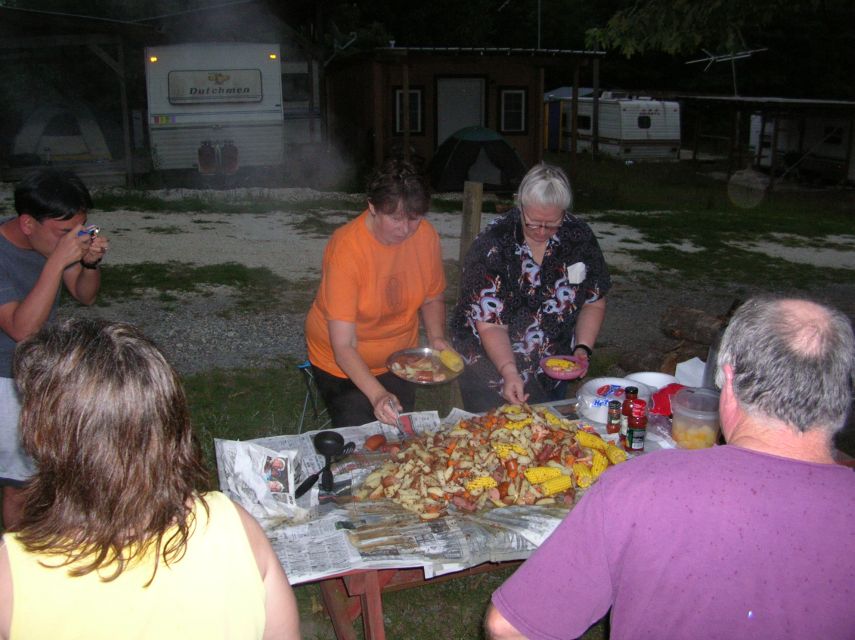
Back in camp, the food fun starts! Members and guests enjoyed a fine low country shrimp boil, with head chef Greg Mestler. Numerous members contributed to its preparation and its disappearing act!
THIS JUST IN ! ! SYLVIE AND MICHAL ARE THE PROUD PARENTS OF ELI MRUG ! Born May 23, 2006.

August 20, 2005 - Eocene Fossils, Covington and Cretaceous Fossils, Montgomery Co, AL
Once again, the group ended the day with a fine opportunity to hang out together at The Swamp, a kinda - sorta local eatery (only 20 minutes away, huh, Greg?) where we stayed way too long, but enjoyed the time spent with fellow fossil hounds.
(Pictures courtesy Jan Novak and Vicki Lais.)
Ron found an unusual heart-shaped item which turned out to be a disk from a deer vertebra. It is very light-weight and recent, not a fossil.
Ron's other interest is gold panning, and he gave some of us a demo, using gold bearing material he found in Georgia.
The water was very high, severely impacting our collecting. Sylvie is walking in a spot that is normally dry. Even the island is flooded.
Searching for shells, teeth and horned coral in the clay banks. Note how high the water is behind us.
Fragments found here are still being identified. Look just above the yellow handle to see the first "rocks", then straight to the left. There are some more fragments in the upper right quadrant. Some are probably turtle.
Greg, turn around! They told me to quit taking pictures of people's rear ends!
What a group of tired, sweaty people. So where do we go to cool off and relax a while?
- ‹ previous
- 3 of 4
- next ›
